Space
Hubble Space Telescope; A portal to the mysterious depths of the universe
Published
2 weeks agoon


Hubble Space Telescope; A portal to the mysterious depths of the universe
Planets are born in a pile of dust; The mysterious and unknown energy that causes the expansion of the universe; Comets are fragmented and asteroids are unbalanced; Galaxies collide to be reborn; A look into the depths of the most distant stars in the world.
From the collection of infinite engineering articles: International Space Station James Webb Space Telescope Space Shuttle; The first reusable spacecraft Dragon SpaceX capsule, the spacecraft of the 21st century
For more than 30 years, the Hubble Space Telescope has brought the wonders, beauties, and mysteries of the universe to earth and has transformed our understanding and knowledge of the world with images created from light. With more than 1.5 million observations of galaxies still high above Earth, far from any obstructions that might deflect the light, the Hubble Telescope is beaming home valuable data that answers some of our most important questions about the cosmos.
Hubble is very old, But it is still the most powerful tool that we humans have at our disposal to explore the farthest parts of the universe. Wherever cosmic bodies emit light, no observatory is better equipped to study them than Hubble. Join us on this space journey to learn about this amazing telescope.
-
What is the Hubble telescope?
-
Why is a space telescope needed?
-
Cosmic discoveries
-
Hubble time machine
-
History of the Hubble Telescope
-
Where is the Hubble telescope?
-
Hubble telescope images
-
1- Sombrero Galaxy
-
2- Cat’s Eye Nebula
-
3- Pillars of Creation
-
4- Hubble Deep Field
-
5- Tarantula Nebula
-
6- The passage of four moons of the planet Saturn
-
7- Crab Nebula
-
8- Whirlpool galaxy
-
9- Spirograph Nebula
-
10- The planet Mars is on the verge of confrontation
-
How does the Hubble telescope work?
-
Where do the colors of the Hubble images come from?
-
The zoom power of the Hubble telescope
-
The birthday of the Hubble telescope
-
The most important discoveries of the Hubble telescope
-
Recent discoveries of the Hubble telescope
-
The future of Hubble
-
Interesting facts about the Hubble telescope
-
mission
-
size
-
Space flight statistics
-
Optical capabilities
-
Hubble mirrors
-
Accuracy of targeting
-
Statistical data
-
Energy consumption
-
Energy storage
-
Anyone can register a request to use the Hubble telescope
What is the Hubble telescope?
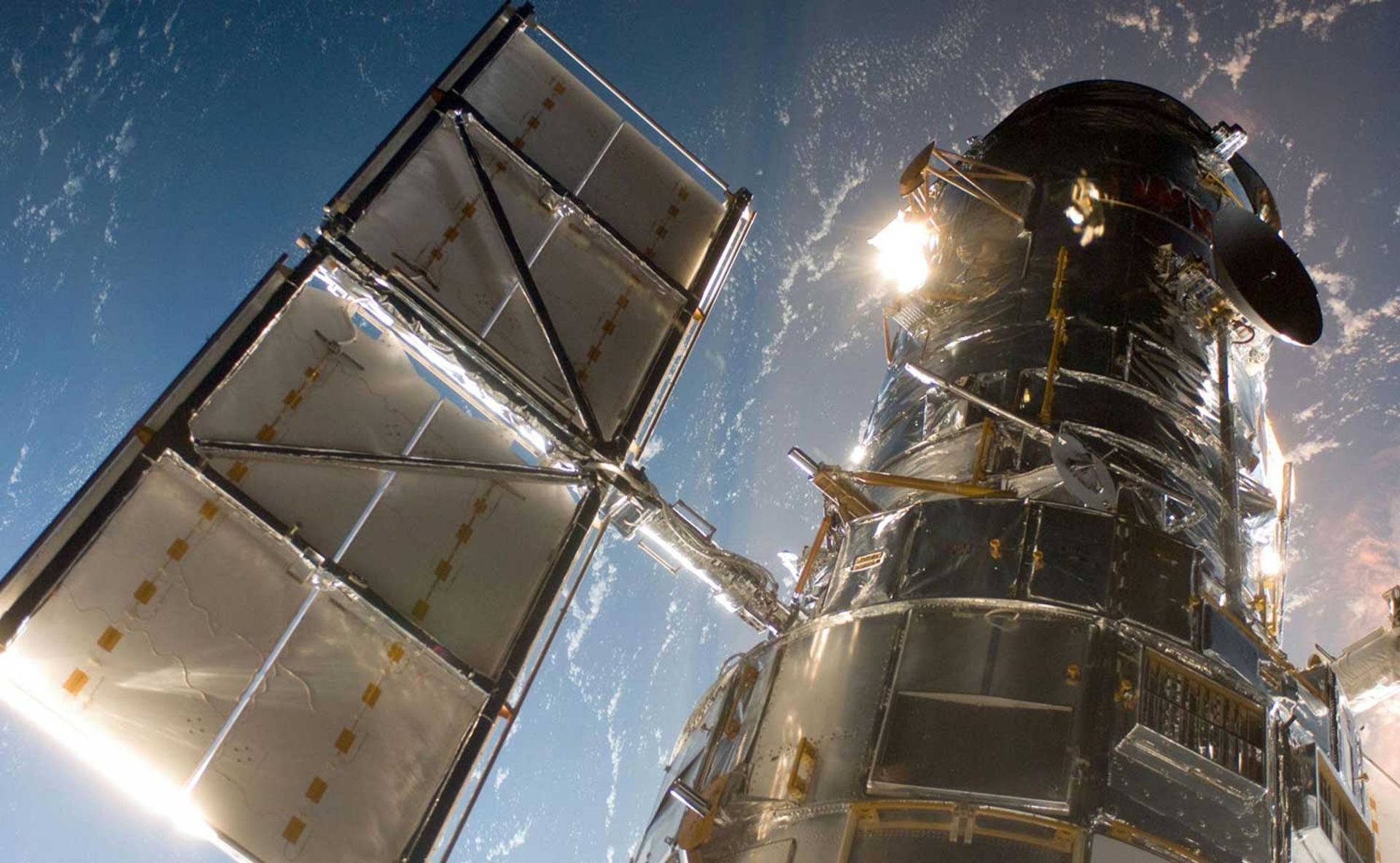
The Hubble Space Telescope (which is often referred to as HST) is an international collaboration project between NASA and the European Space Agency, which was launched into the near-Earth orbit by the space shuttle Discovery on April 24, 1990 (May 4, 1369) and after 31 Sal continues his mission. Hubble was not the first space telescope to successfully orbit, But it was bigger and better equipped than its fellows, and its amazing discoveries completely changed the human vision of the universe.
Hubble is orbiting about 547 km above the Earth’s surface. Its length is 13.2 meters, which is the size of a big bus, and its weight is 12,200 kilograms, which is the size of two adult elephants. Hubble uses solar energy and moves at about 8 kilometers per second to stay in orbit.
The Hubble telescope takes very high-resolution images of celestial bodies such as planets, stars, and galaxies, and has recorded more than 1.5 million galaxy observations. These observations include detailed images of the birth and death of stars, galaxies billions of light-years away, and remnants of comets that hit planets’ atmospheres.
Hubble was developed as a general-purpose space observatory with the aim of exploring the universe and recording images in visible, ultraviolet, and infrared wavelengths. So far, this telescope has studied more than 40,000 cosmic objects and has provided high-resolution and detailed images to astronomers who could not see them from Earth.
In addition to blocking some wavelengths of light completely, the Earth’s atmosphere contains air currents that are constantly moving and cause the stars to twinkle in the night sky. The constant movement of these air currents blurs the images taken by ground-based telescopes; For this reason, it was necessary to place a telescope in an orbit above the atmosphere to record images free of these effects.
Hubble’s mirror is much smaller than that found in the largest ground-based observatories, But the unique position of this telescope above the Earth’s atmosphere gives extraordinary clarity to the recorded images. As this telescope rotates around the earth, the mirror collects the cosmic lights and transmits them to the earth in the form of images and data. To photograph some of the most distant objects in the sky, the telescope stares at a point in the galaxy for days to capture as much of this very faint glow as possible.
Why is a space telescope needed?

Cosmic discoveries
Before the Hubble telescope was launched into space, the age of the universe was estimated to be about 10 to 20 billion years; But Hubble was able to reduce this big difference to about 13.8 billion years by examining a special group of stars that are used in determining the distance. This figure is now considered the approximate age of the universe and is used to understand the condition of stars, galaxies, and more.
Hubble has also discovered large black holes in the heart of galaxies and has shown the existence of dark matter around galaxy clusters, But perhaps one of Hubble’s strangest discoveries was that the expansion of the universe is accelerating due to the presence of previously unknown “dark energy”.
Hubble has also been used to investigate the climatic conditions in the planets of the solar system and the birth of planets in other systems. This satellite has investigated the composition of the atmosphere of these “supersolar” planets and managed to record one of the first images of such a planet with visible light. With its ability to capture pristine images of the universe, Hubble has repeatedly shown humanity that there are still many secrets about the universe. Because of Hubble, we have a better understanding of the solar system and how it works.
Hubble time machine
The vastness of space is so indescribable that even light at its exemplary speed takes considerable time to pass through cosmic bodies. For example, light from the moon takes about 1.3 light seconds to reach our eyes, so when we look at the moon in the sky, we see it as it was 1.3 seconds ago, 1.3 seconds in the past.
The light of the most distant cosmic objects started moving in space billions of years ago, and when it finally reaches the corner of our universe, it shows us the way it was billions of years ago. By recording the faint light that reaches it from the early universe, Hubble can see galaxies as they were billions of years ago and show us how galaxies have evolved over time.
We cannot see the evolution of galaxies or stars, because this evolution happens on a time scale of millions and billions; But by observing them in different stages of their existence, Hubble has been able to draw a picture of how galaxies change and evolve.
History of the Hubble Telescope
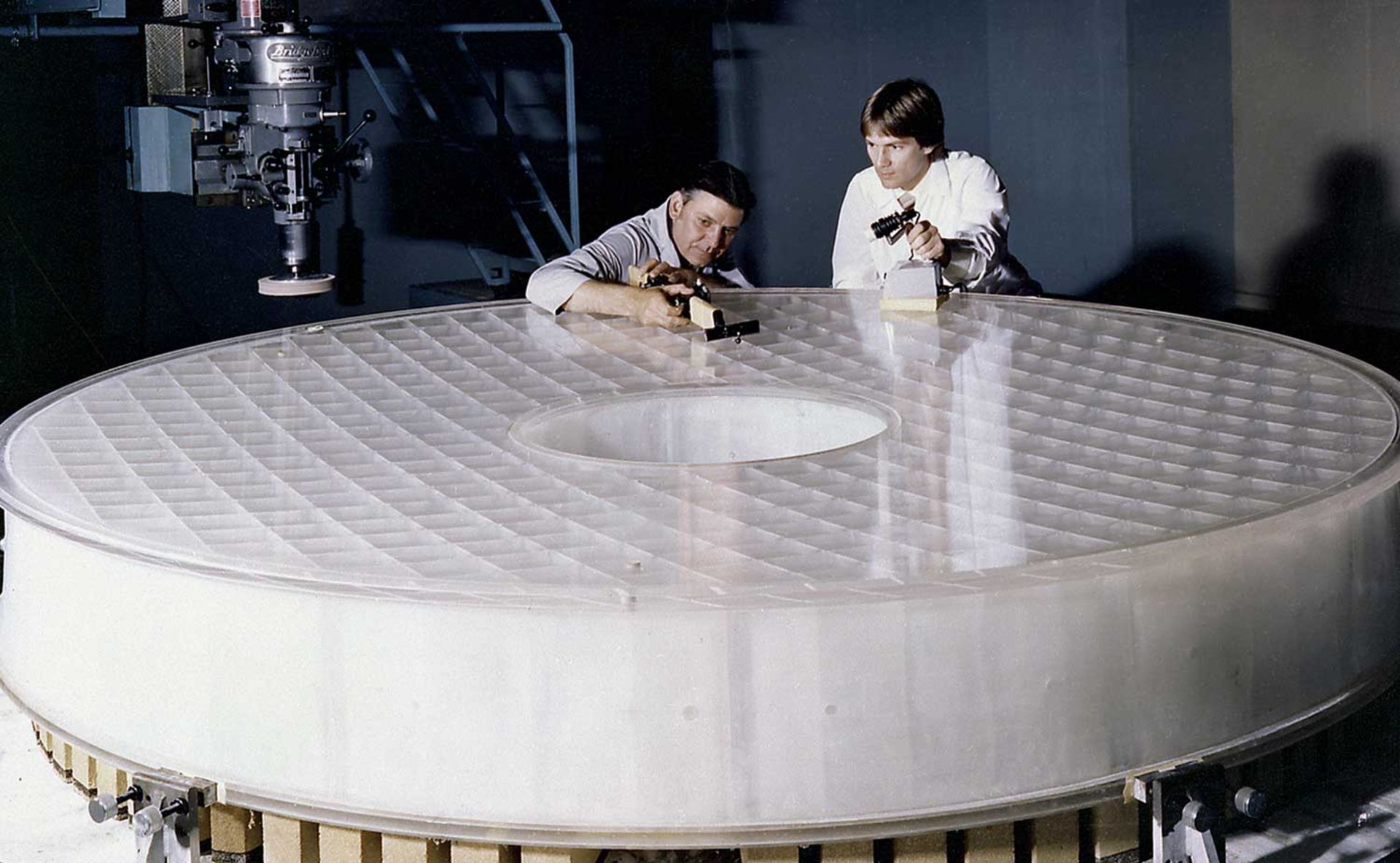
The Hubble Space Telescope takes its name from Edwin Hubble, a famous American astronomer, whose observations showed scientists that there are other galaxies in the universe besides the Milky Way. While working at the Mount Wilson Observatory in 1923, Hubble concluded that Andromeda then considered a nebula, was actually an independent galaxy hundreds of thousands of light-years away from the Milky Way.
Also, in 1929, by discovering that galaxies are moving away from each other at a constant speed, he put a stamp on the “static universe” theory and thus laid the foundation for the Big Bang theory. Edwin Hubble died in 1929, But the telescope that bears his name has since confirmed and modified many of his theories.
Of course, the idea of building a space telescope dates back to 1946; That is, more than 10 years before the establishment of NASA. It was in that year that astrophysicist Lyman Spitzer Jr. wrote an influential paper on the merits of a space-based observatory. In this paper, he argued that an orbiting telescope could observe the sky without encountering the Earth’s atmosphere, which blurs the images and records very high-resolution images.
Spitzer was later instrumental in building the four unmanned Orbiting Astronomical Observatory satellites that NASA launched between 1966 and 1972 and tirelessly petitioned the US government for funding to build a bigger and better space telescope. The huge costs of this project were a big obstacle to its realization, and it was only in 1977 that the American Congress finally agreed to allocate funds for the construction of the telescope, which was named Hubble.
The fledgling Hubble project suffered a major blow in 1986 when the space shuttle Challenger exploded during takeoff, killing seven astronauts. Following this tragic disaster, NASA grounded its space fleet and left Hubble, which needed a shuttle for transportation and repairs, without a vehicle. Of course, scientists made good use of this opportunity and improved the sensitivity of the telescope instruments and improved its ground control software; But these years of delay imposed huge costs on NASA to service and maintain Hubble in a clean and advanced room. When the space shuttle Discovery finally launched Hubble in 1990, the project was seven years behind schedule and over $1 billion over budget.
Unfortunately, this was not the end of Hubble’s problems. That same year, when NASA scientists viewed the first images recorded by Hubble, they discovered that its primary mirror had been polished to the wrong specification. This “spherical deviation” was very small; In fact, less than 1/50 of the width of a human hair; But this slight deviation was enough to blur many Hubble pictures.
Within months, the telescope had become something of a national joke, with one Newsweek magazine even calling it a “$1.5 billion mistake.” NASA had to wait until December 1993 to experience good things; That is when a group of scientists installed a contact lens called COSTAR on Hubble to fix this deviation. Consisting of several small mirrors, Quastar captured the beam emitted by the defective mirror, corrected the defect, and then reflected the corrected beam back to the center of the mirror for analysis.
Hubble’s “space glasses” managed to solve the problem of blurred images, and soon after this telescope began to record amazing images of the universe. Of course, today all the instruments installed in Hubble have internal corrective optics to compensate for mirror defects, and COSTAR is no longer needed.
Where is the Hubble telescope?
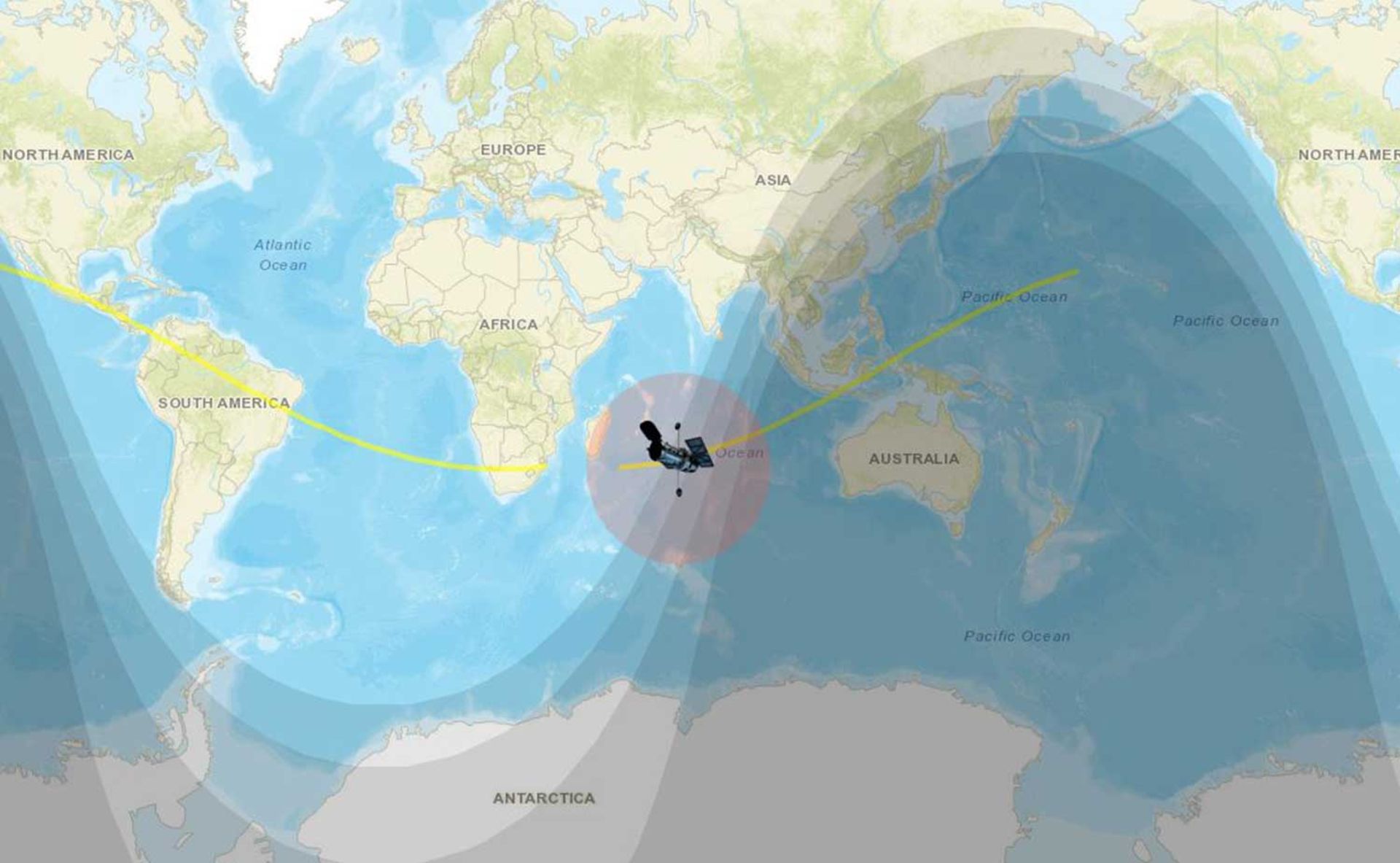
When the Hubble telescope was launched, it was at a height of 547 km from the earth’s surface; But most of the time it orbits the earth at an altitude of 320 km and sometimes it rises to an altitude of 400 km to visit the International Space Station.
Currently, Hubble’s nearly circular orbit is located at an altitude of 550 km from the Earth’s surface, and each revolution of this telescope takes about 96 minutes. In this way, Hubble goes around the earth 15 times a day; But not everyone can see it in the sky.
Hubble is best seen in regions on Earth between latitudes 28.5 degrees north and 28.5 degrees south. The reason is that Hubble is at an orbital deviation of 28.5 degrees from the equator. This orbital deviation is the same as the latitude of Hubble’s launch site, Cape Canaveral in Florida, and was the easiest and most economical orbit to launch the telescope.
It is not possible to watch the passage of the Hubble telescope from the sky in Iran; But if you want to see where the Hubble telescope is above the earth at this very moment, you can visit the website uphere.space, which provides a real-time image report of Hubble’s movement in orbit. It is also possible to watch the passage of other satellites on this website.
Hubble telescope images
Since the Hubble telescope was put into orbit (31 years ago), more than 1.5 million images have been recorded. Here we review 10 examples of the most amazing and iconic images recorded by Hubble:
1- Sombrero Galaxy

The Mexican cap galaxy is very photogenic. Known for its bright white core, this galaxy is located 28 million light-years from Earth in the constellation Virgo.
2- Cat’s Eye Nebula
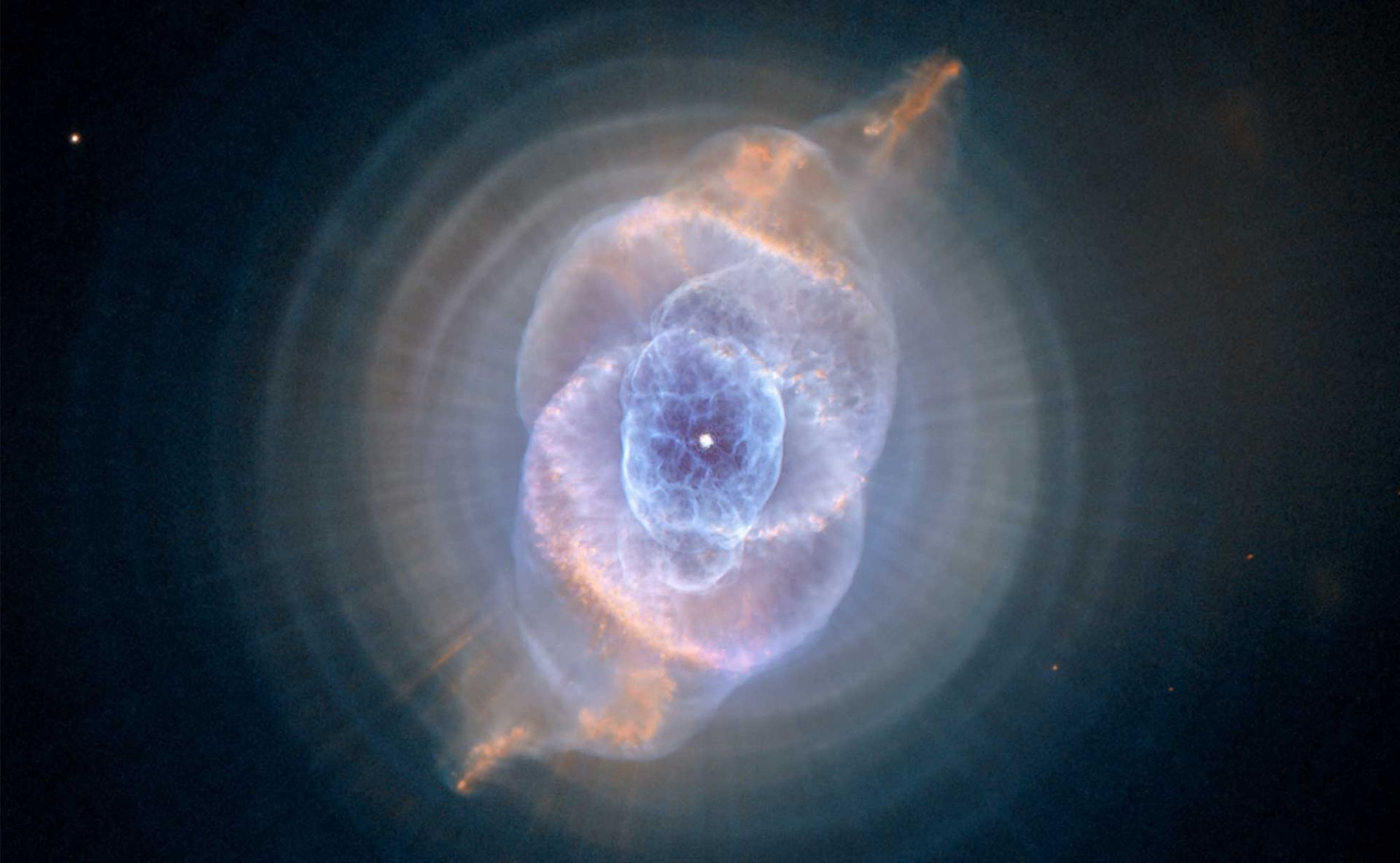
The Cat’s Eye Nebula is located at a distance of about 3,300 light-years in the constellation Dragon and is also called the Sunflower Nebula or the Snail Nebula. In the center of this nebula is a bright and hot star that lost its outer covering about a thousand years ago which led to the formation of this nebula. This nebula was discovered in 1786 by William Herschel, the discoverer of Uranus.
3- Pillars of Creation
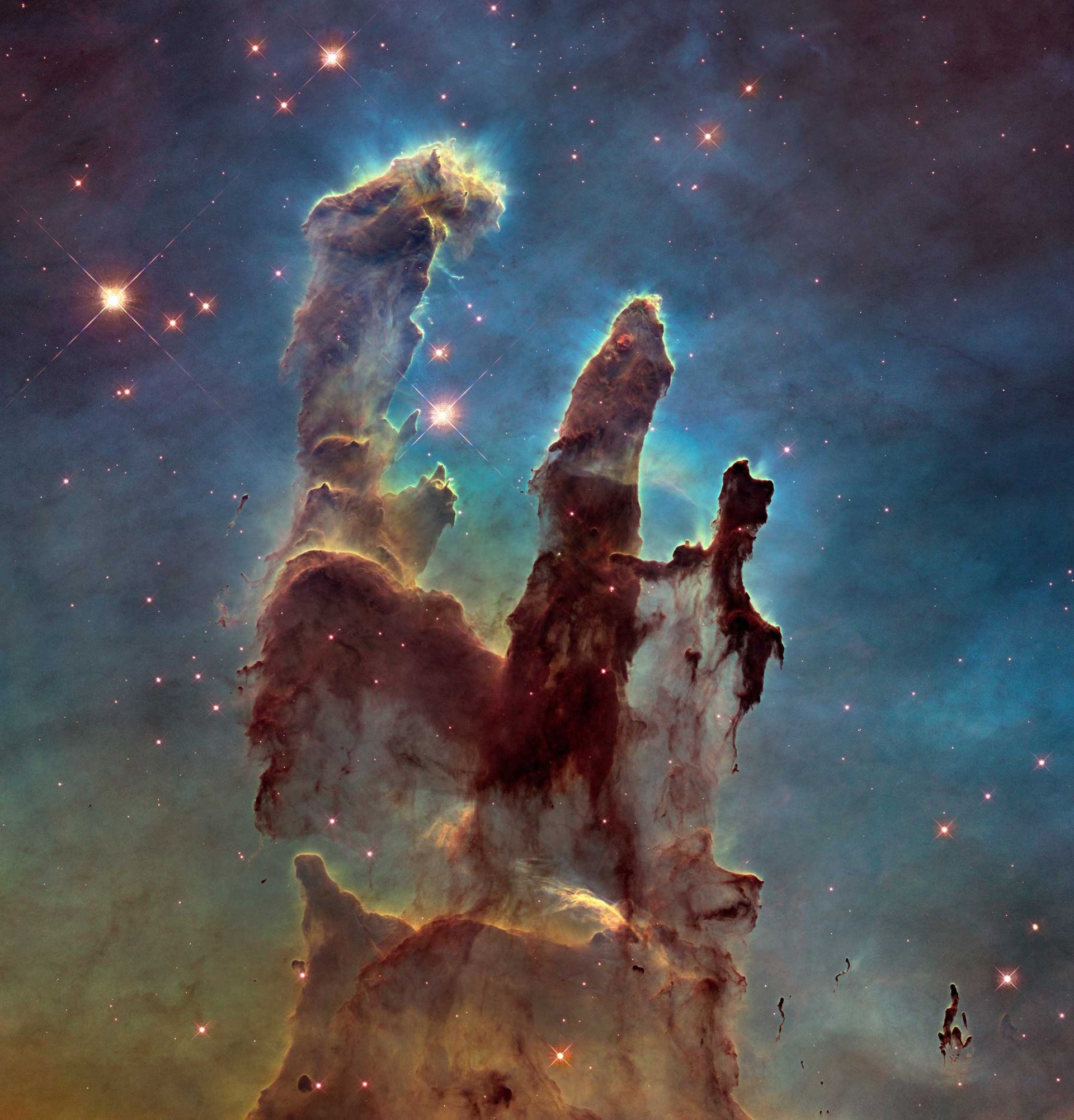
Undoubtedly, the most iconic image captured by Hubble to date is the “Pillars of Creation” taken in 1995. These giant towers consisting of interstellar gases and cosmic particles are located at a distance of 7,000 light years from Earth in the Eagle Nebula.
The reason for choosing the name of the pillars of creation is that a very powerful force of gravity causes these gases and particles to condense and turn them into masses of mass and form a new star system. In fact, the solar system was probably born billions of years ago in the same way. When we look at this picture, it is as if we are looking at the distant past of the earth.
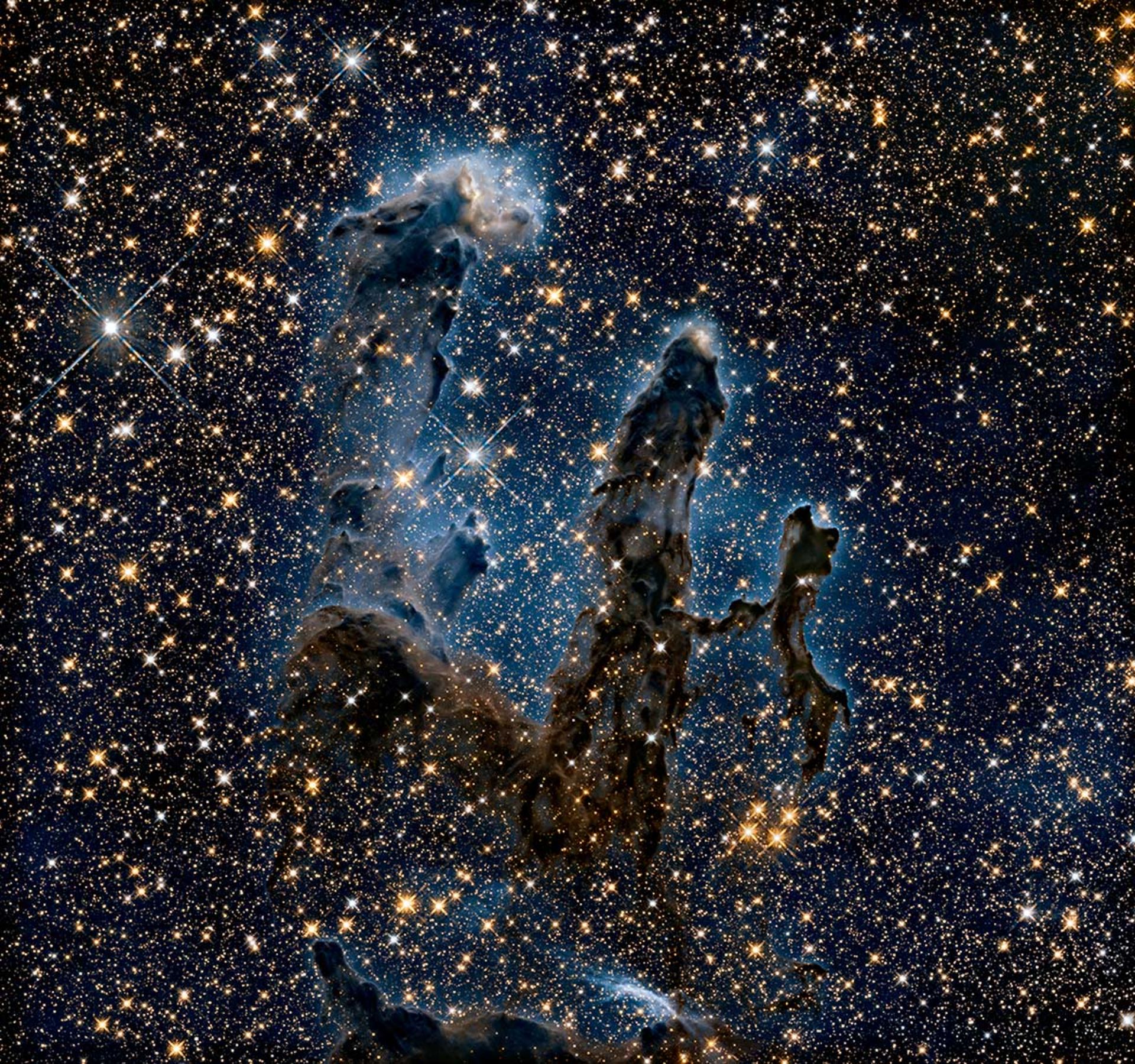
The image above is the same columns of creation recorded with infrared light and as a result, dust and gases can be seen inside. The website space.com has selected the Pillars of Creation as one of the top ten images taken by Hubble.
4- Hubble Deep Field
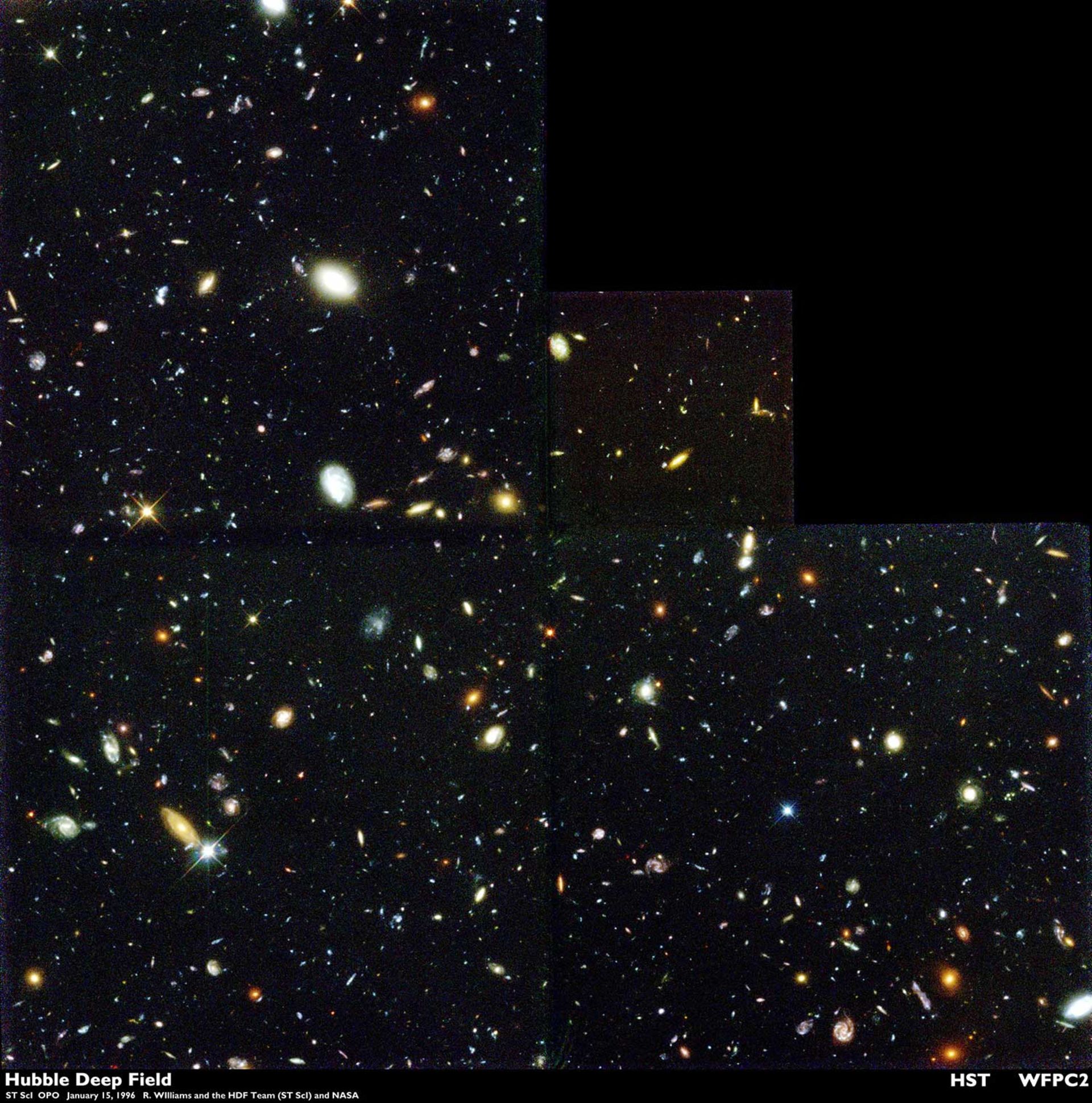
Hubble’s Deep Field is a stunning image of a section of the Ursa Major constellation that changed the science of astronomy forever. This image, taken in 1995, is as wide as a grain of salt; But it has 3 thousand galaxies in its heart. This image is composed of 342 separate pieces obtained by Hubble’s Deep Wide Astronomical Camera 2 during ten consecutive days.
5- Tarantula Nebula
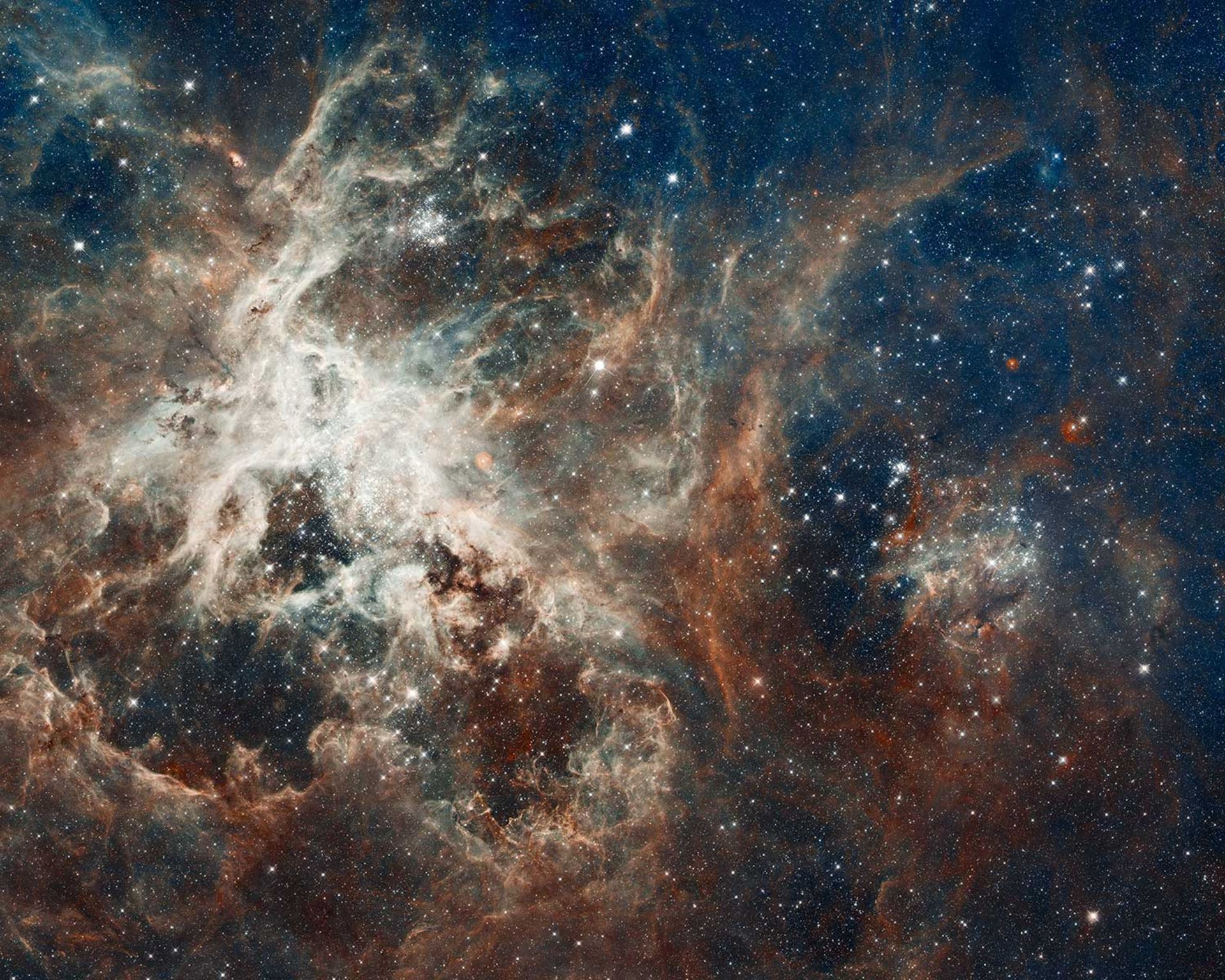
In this incredibly beautiful image, we are watching the birth of half a million young stars in the middle of a cloud of gas and cosmic particles in the Tarantula Nebula, which is located in the constellation of the Golden Fish at a distance of 160 thousand light years from us; But this nebula is not in the Milky Way galaxy but in the Large Magellanic Cloud galaxy.
The Tarantula Nebula is the brightest non-stellar object ever discovered, and if the Orion Nebula were in the Milky Way, its shadow would fall on Earth.
6- The passage of four moons of the planet Saturn
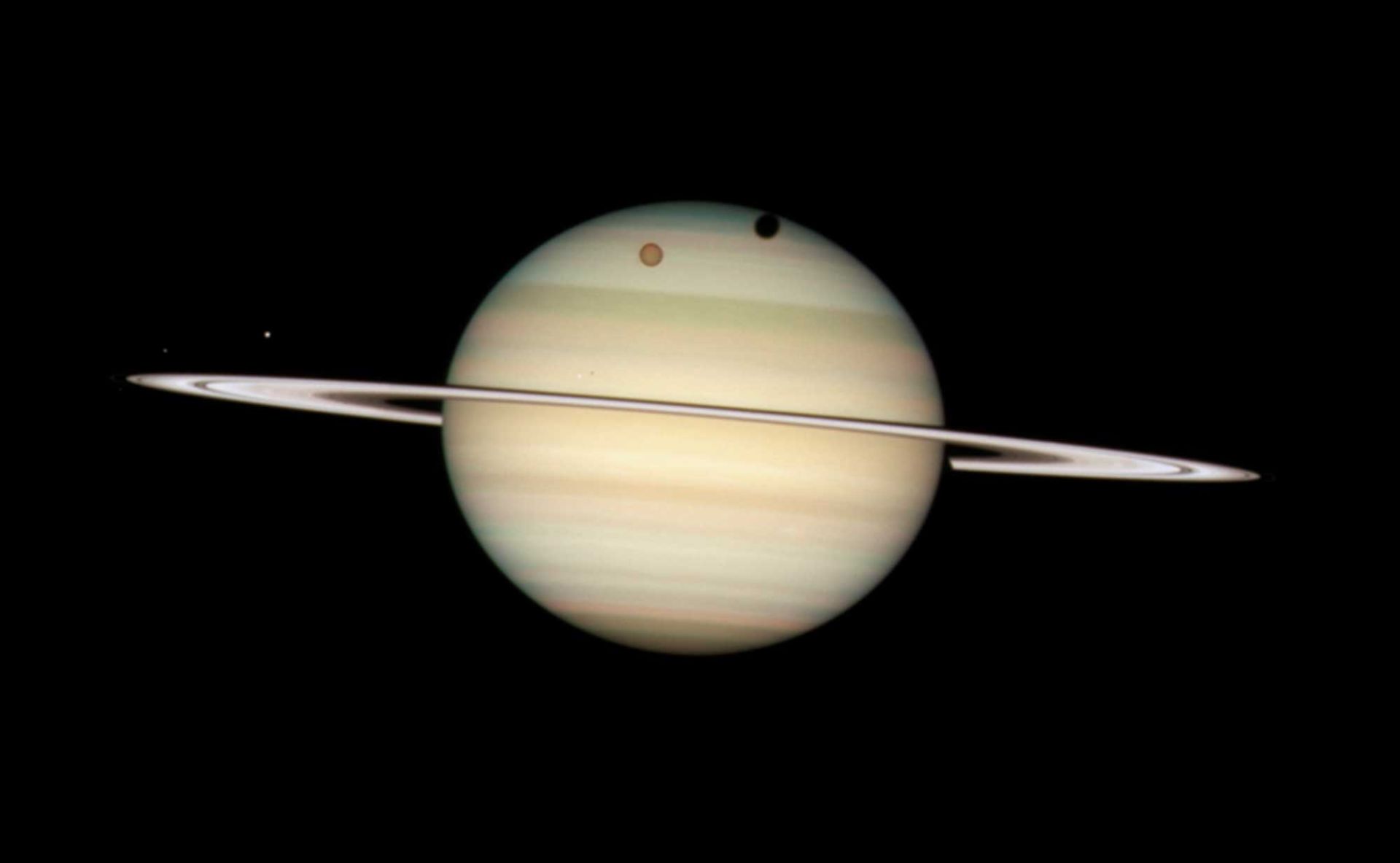
Saturn has 82 moons, But the passage of the moons over this planet can be seen only when the tilt of Saturn’s rings reaches the point where they look edged, and this event happens once every 14-15 years. This image was captured by Hubble’s Deep Wide Astronomical Camera 2 on February 24, 2009.
7- Crab Nebula
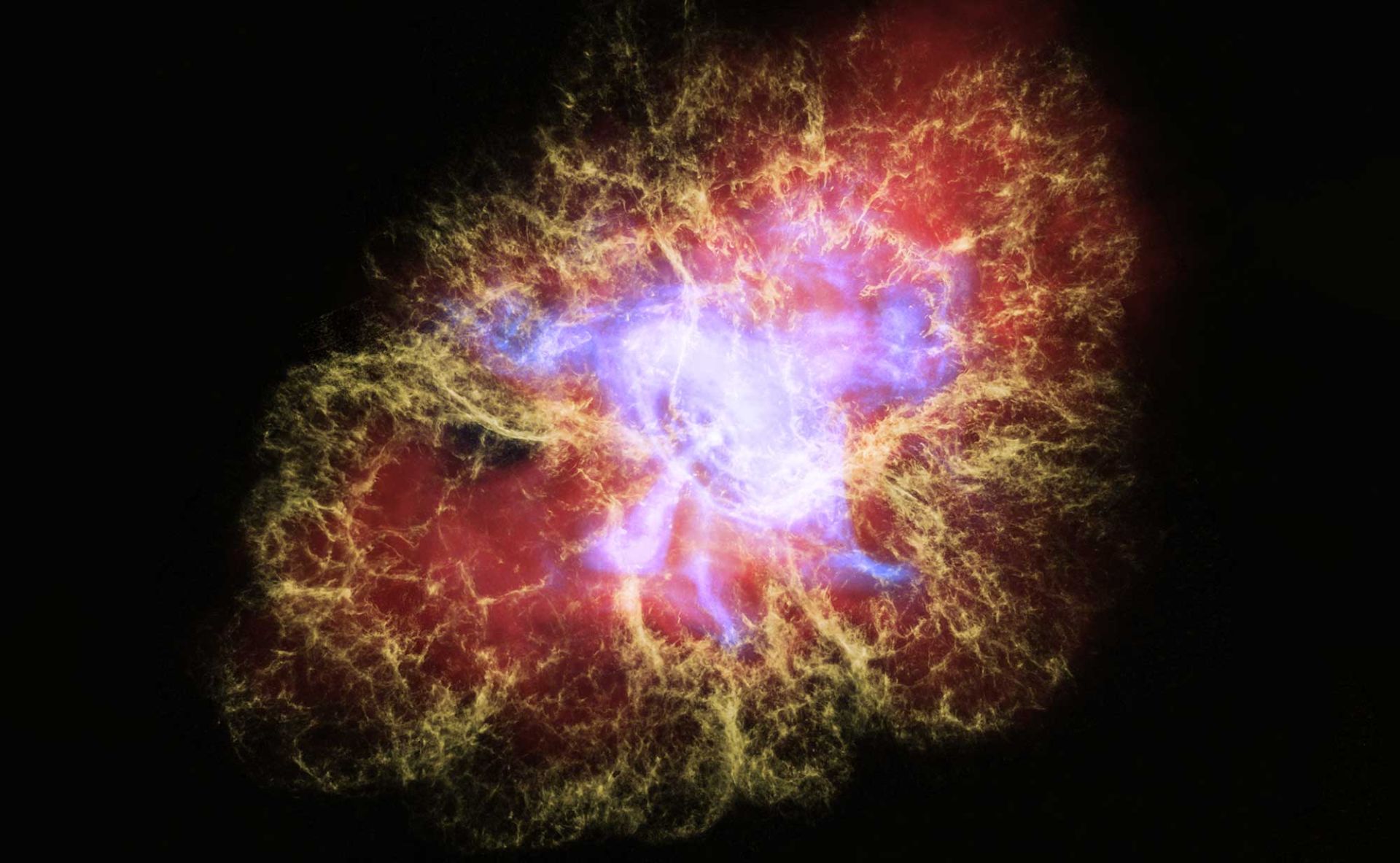
The Crab Nebula is located about 6,500 light-years from Earth in the constellation Taurus and is the only survivor of the supernova explosion that Chinese astronomers observed in 1054 AD. This image is obtained in several wavelengths and from the data of three telescopes, the yellow light belongs to Hubble.
8- Whirlpool galaxy
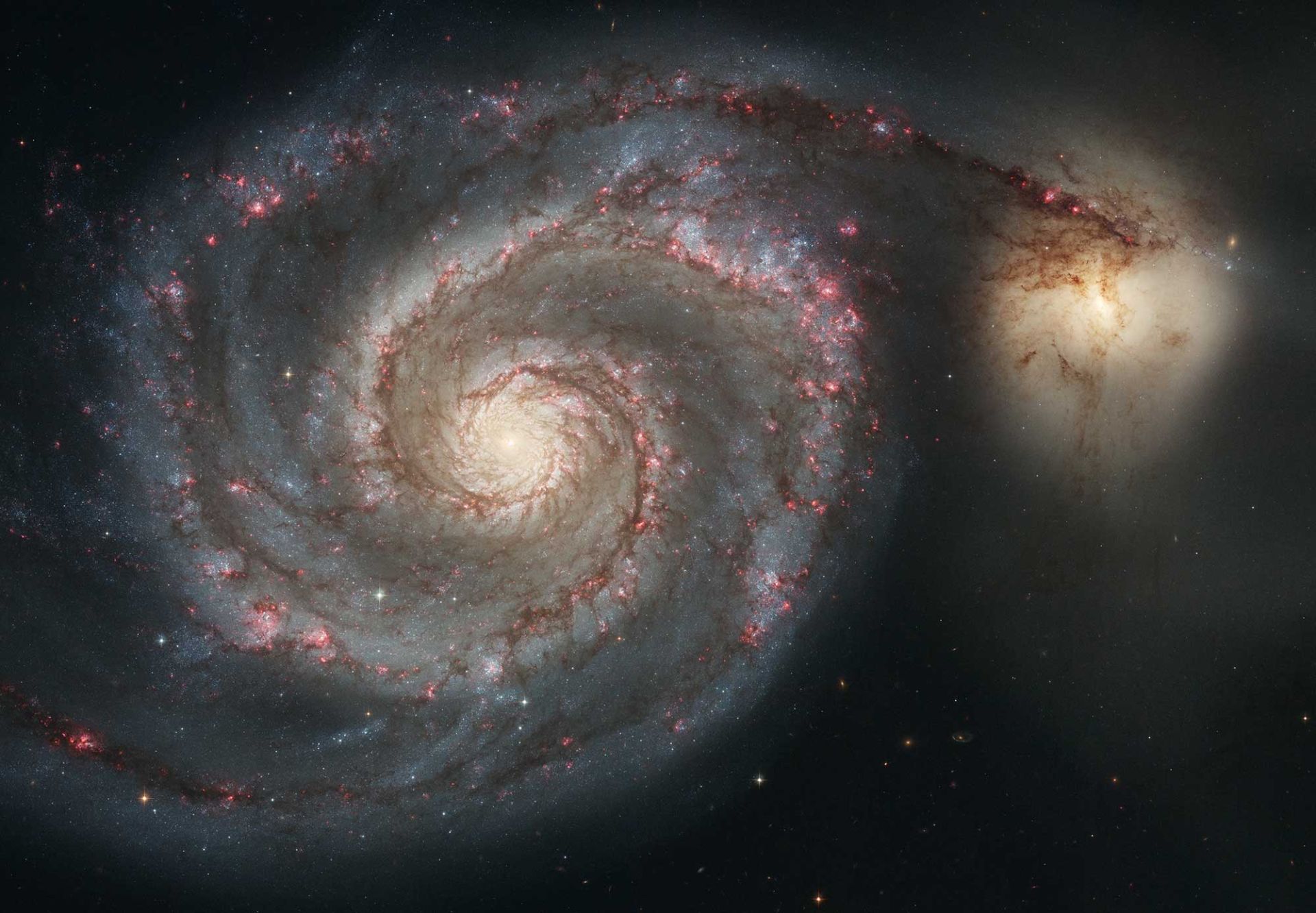
The Whirlpool Galaxy or NGC 5194 is an interacting and spiral galaxy located 31 million light-years from Earth in the constellation of the Hounds. This galaxy and its companion, NGC 5195, are easily visible to amateur astronomers and can also be seen with spotting scopes.
9- Spirograph Nebula

The planetary nebula IC 418, known as the Spirograph (due to its apparent resemblance to Euclid’s magic circle), is located about 2,000 light-years from Earth in the constellation Wolf, near the constellation Orion.
The IC 418 nebula was a Sun-like star a few million years ago and became a red giant a few thousand years ago. With the end of the nuclear fuel of this star, its outer shell was ejected and a planetary nebula was formed. In the center of this image, you can see the white dwarf.
10- The planet Mars is on the verge of confrontation
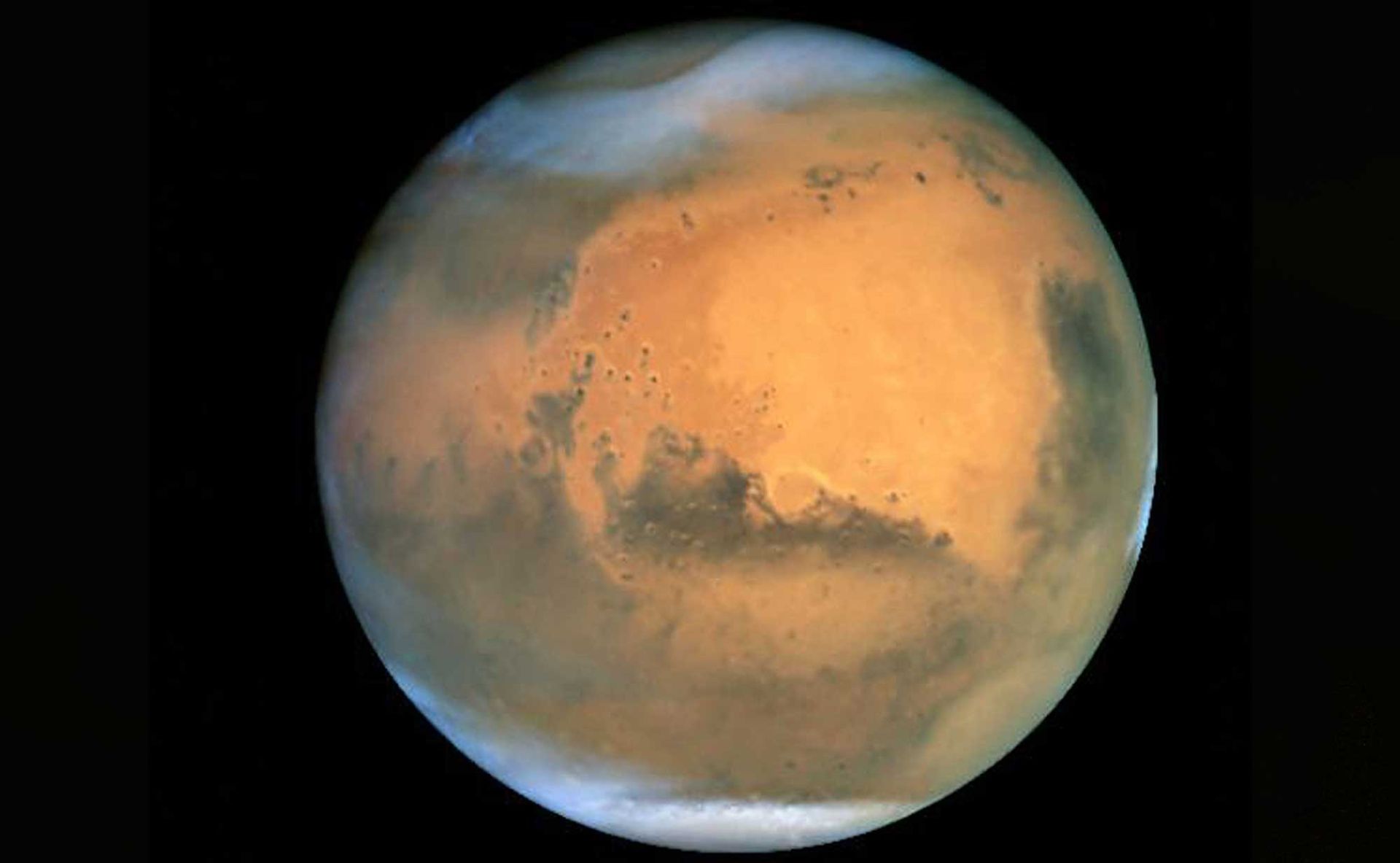
Earth comes between Mars and the Sun about once every two years, causing the red planet to glow spectacularly. Hubble recorded this event, called a collision, in 2001.
How does the Hubble telescope work?
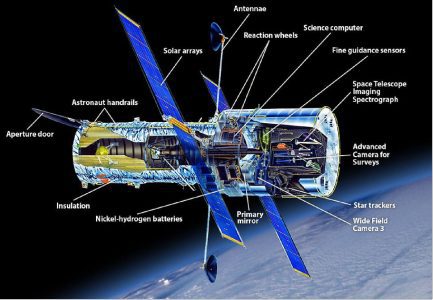

The Hubble telescope, 13.2 meters long and currently weighing 12,200 kg, provides its energy with the help of two 7.62 meter panels from the sun and stores it in 6 nickel-hydrogen batteries with a capacity equal to approximately 22 car batteries. saves This telescope is made up of various instruments, each of which is responsible for recording the highest-quality galactic images.
As the telescope orbits the Earth, its Fine Guidance Sensors lock onto the stars. These sensors are part of the pointing control system and guide the Hubble in the right direction. Hubble can lock onto a target a mile away without moving more than the width of a human hair.
After detecting the target, Hubble’s main mirror begins to collect light. This mirror can collect about 40 thousand times more light than the human eye. Light is reflected from the primary mirror to the secondary mirror. The secondary mirror then refocuses the light through a hole in the primary mirror. From there, light shines on Hubble’s scientific instruments.
Hubble has five scientific instruments, including cameras and spectrographs, each with a different way of reading light. Spectroscopy is a tool that divides light into separate wavelengths.
Hubble’s main camera is called Wide Field Camera 3. The camera studies everything in the universe, from the formation of distant galaxies to the planets of the solar system, and can observe three different types of light: near ultraviolet, visible light, and near-infrared. While the human eye can only detect visible light, the Hubble camera can also observe and record near-ultraviolet and near-infrared. Of course, Hubble can only record one type of light at a time.
The Advanced Camera for Surveys takes pictures of large areas in space and has a very high resolution, quantum efficiency, and powerful emulsion filters. This camera increased the resolution of Hubble’s images by 10 times and showed scientists parts of the universe that had never been seen before.
Hubble’s Cosmic Origins Spectrograph reads ultraviolet light. This spectrograph studies the formation and evolution of galaxies, stars, and planets.
Somewhat like a prism, the Space Telescope Imaging Spectrograph breaks down the light that reaches the telescope from celestial objects into its constituent colors, helping scientists determine the temperature, chemical composition, density, and motion of objects in space. determine This spectrograph is also used to detect black holes.
The Near-Infrared Camera and Spectrograph (NICMOS) can sense the heat emitted from distant objects and observe them and spectrograph multiple targets simultaneously. The sensitivity of this camera to infrared waves has made it very efficient for seeing obscure celestial objects such as gases and interstellar dust, as well as for seeing the deepest parts of the universe.
Where do the colors of the Hubble images come from?

Hubble sends about 150 gigabytes of scientific data to Earth every week. This amount of data is equal to about 45 two-hour movies with HD quality or about 30 thousand mp3 songs. Digital signals are transmitted from Hubble to satellites, then to a ground station, from there to NASA’s Goddard Space Flight Center, and finally to the Space Telescope Science Institute. This institute transforms data into images and information that we can understand.
Hubble’s digital cameras can only take black and white photos; For this reason, astronomers put the recorded image of the object in several exposure modes to record different wavelengths of light using several filters, which are usually red, blue, and green. These images are then superimposed to create a monochrome image. Because Hubble can see in the ultraviolet and infrared ranges, scientists sometimes add extra color to the images to bring out details that are normally invisible to the human eye.
The zoom power of the Hubble telescope
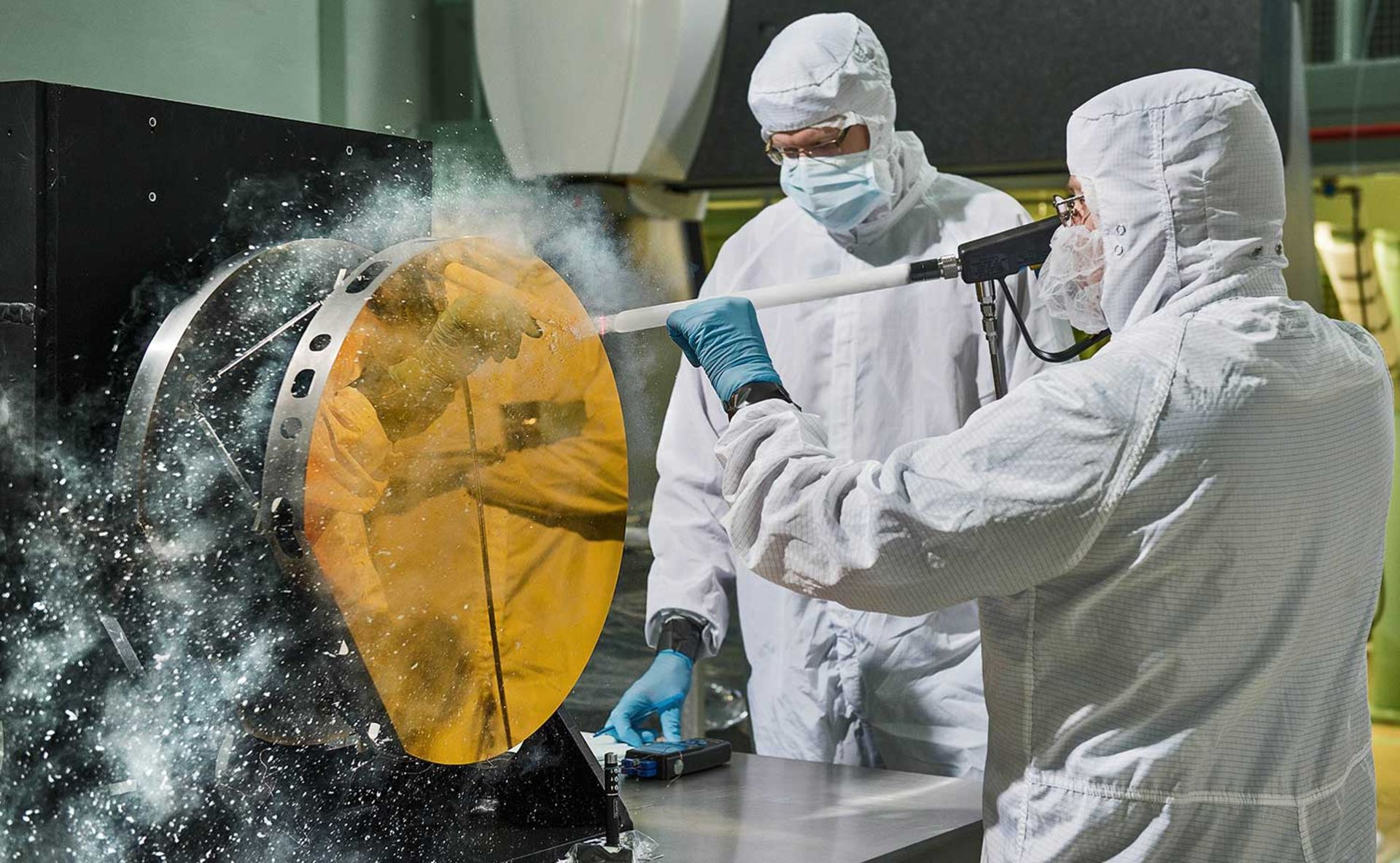
The Hubble telescope is so powerful that it can detect the light of a firefly at a distance of about 11,000 kilometers, and scientists have used this amazing ability to understand many mysteries of the universe. For example, astronomers’ estimates of the age of the universe in the past differed greatly; But Hubble’s observations of old, burned-out stars helped them narrow down the Big Bang to about 13.7 billion years ago.
This telescope was also able to find early signs of supermassive black holes at the center of neighboring galaxies with the help of its high zoom power. The role of this telescope has been very vital in discovering exoplanets that may have suitable conditions for life. Perhaps Hubble’s most important discovery from the study of supernovae was the formation of the theory that a mysterious force known as “dark energy” may be the reason for the acceleration of the universe’s expansion, and this discovery would not have been possible without Hubble’s powerful lenses.
As Hubblesite explains, people often mistakenly think that the power of a telescope depends on its ability to magnify objects; But the fact is that the power of telescopes lies in gathering more light than the human eye can absorb, and the greater the ability of the telescope to gather light, in other words, the larger the surface of the telescope’s mirrors, the greater its power. The Hubble telescope also does this using a technique that was first presented 340 years ago; A technique called Cassegrain reflector, which consists of two convex and concave mirrors. The large, convex primary mirror absorbs light (Hubble’s primary mirror is 2.4 meters in diameter) and reflects it back to a smaller, concave secondary mirror (0.3 meters in diameter on Hubble). The light is then reflected through a hole in the middle of the primary mirror onto the sensors of the Hubble instrument.
Thanks to its large and powerful mirrors, Hubble can look deep into space; But only by looking at the NASA images, you can’t understand the incredible zoom power of this telescope. For this reason, astronomers have published a large number of images recorded by Hubble at different distances in the form of a video that shows off the power of Hubble’s mirrors in the best possible way.
The birthday of the Hubble telescope
On April 24, 1990, corresponding to May 4, 1369, the space shuttle Discovery took off from the earth with its very valuable cargo, the Hubble telescope. The next day, April 25, a team of astronomers put this telescope into space and Hubble’s exploratory journey began. On that historic day, no one could have predicted the wonders that Hubble was going to observe and record in the next 31 years.
In the same way, April 24th is Hubble’s birthday, and every year on this day, NASA publishes a beautiful and new image recorded by Hubble. Last year, on the occasion of the end of three decades of the Hubble mission in space, NASA published a new and amazing image of two nebulae in the Large Magellanic Cloud, which is a small galaxy at a distance of 163 thousand light years from the Milky Way.

The larger, red nebula is called NGC 2014, and the bright, newly formed stars at its heart are 10 to 20 times the size of the Sun. The blue nebula known as NGC 2020 was formed when a star 200,000 times larger than the Sun ejected a large amount of gas. To the eyes of the researchers, this recorded image resembled a rock or a coral reef; That’s why they named it “Cosmic Reef”.
The Hubble telescope explores the world 24 hours a day, seven days a week. That means the telescope has observed and recorded cosmic wonders every day of the year, including your birthday. To find out what image Hubble recorded on your birthday, you can go to this page on the NASA website and enter your birthday month and day in Gregorian.
The most important discoveries of the Hubble telescope
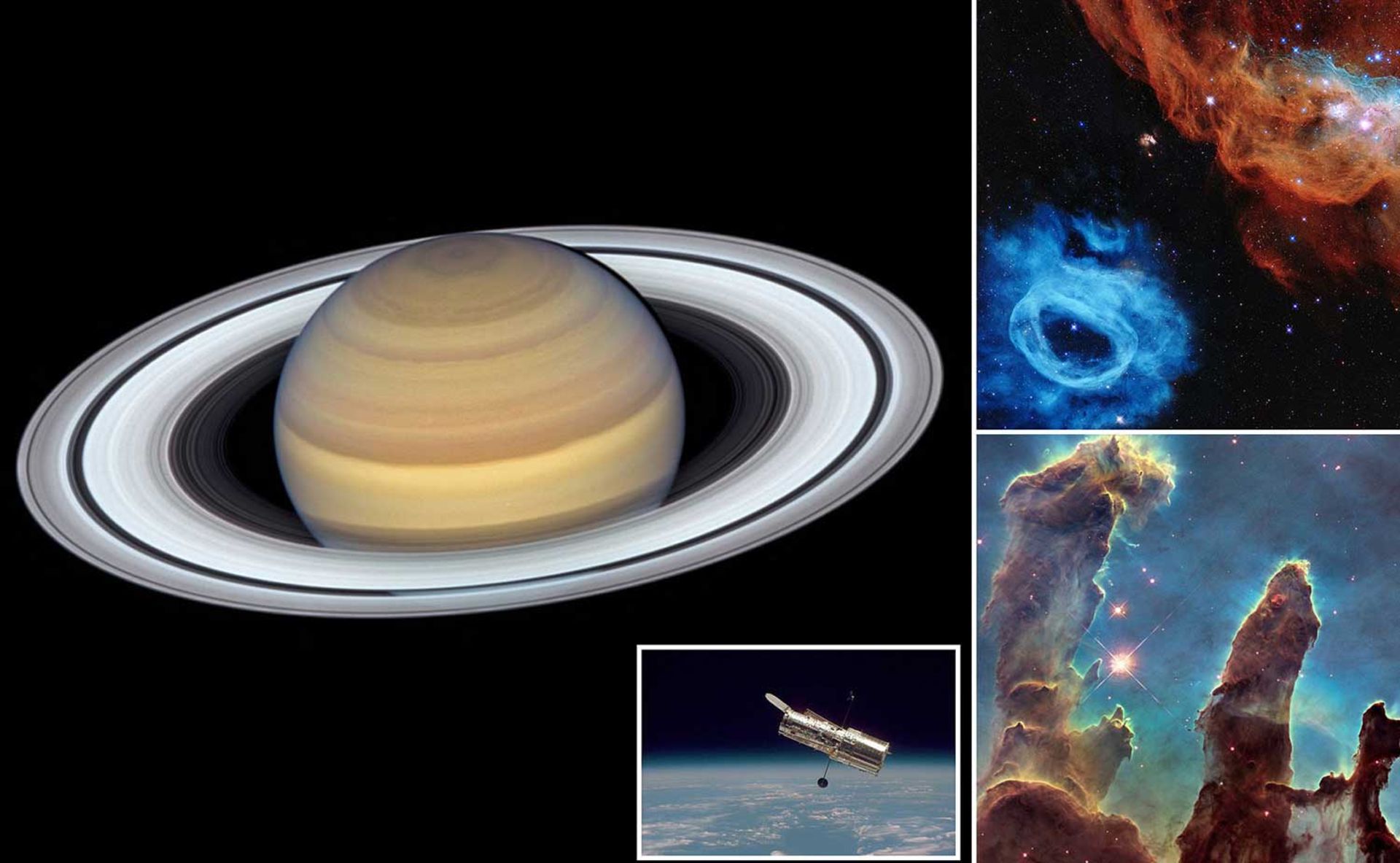
Because of its position in space and its advanced lenses, the Hubble telescope can look at the most distant places that are hidden from the view of telescopes based on the Earth. Since it takes a long time for light to travel long distances, Hubble’s amazing capabilities make it a kind of time machine. The light that Hubble observes from distant objects only shows what the object looked like when the light left it, not what it looks like today; So when we look at the Andromeda Galaxy, which is 2.5 million light-years away from Earth, we see it as it was 2.5 million years ago; It is as if we are looking very far into the past.
Therefore, with Hubble, you can observe very distant cosmic objects that would never be visible without this telescope. For example, in 1995, when astronomers pointed the Hubble telescope at a seemingly empty region in the constellation Ursa Major, not expecting the telescope to capture an image of this region, to their disbelief, after 10 days, images of more than 3,000 observed the galaxy. This image was later named “Hubble Deep Field” (Hubble Deep Field), which you saw in the Hubble Telescope Images section.
Some of the galaxies recorded in the Hubble Deep Field were so young that they had not yet begun to form stars in earnest. A little later, other background observations were made in the same area, each time looking deeper into space. The “Hubble Ultra-Deep Field” image, which was released in 2004 and has four times the resolution of the Hubble Deep Field, is the deepest and most distant point in the universe that the human eye has seen. The galaxies recorded in this image are about 13 billion light years away from us; That is when the universe had spent only 5% of its current life.
By observing the early universe, Hubble helped astronomers calculate the time since the Big Bang, thus estimating the age of the universe in the range of 13.7 billion years. This telescope also examines stars separately in different stages of their evolution; From the clouds of cosmic particles that form newborn stars to the remnants of stars that exploded long ago and those that are at the limit of the distance between these two stages. Hubble has been able to look into the Milky Way, neighboring galaxies, the Magellanic Clouds, and the Andromeda Galaxy.
But more challenging than observing stars is observing planets that orbit other suns outside the solar system. However, in 2008, Hubble captured images of Fomalhaut b, the first time an extrasolar planet had been directly imaged in visible light. Most planets are very difficult to photograph. Most recorded images of planets have been obtained by detecting their atmospheres as they pass in front of their sun; In this way, the atmosphere of these planets filters the light of the stars and Hubble records these changes.
Hubble may spend most of its time looking at objects that are light-years away from Earth, But sometimes it also takes pictures of the planets that revolve around our sun. The images recorded by Hubble of Jupiter, Saturn, and even Pluto are of such clarity and detail that only probes orbiting these planets can capture them better. Hubble images allow scientists on Earth to observe changes in the atmosphere and surface of these planets. When Comet Shoemaker-Levy 9 collided with Jupiter in 1994, Hubble recorded the fatal collision. In fact, this event was the first direct observation of an extraterrestrial collision in the solar system and received extensive media coverage. After this collision, a lot of information about the atmosphere of this gas giant was revealed.
Additionally, in 2014 and 2016, Hubble was able to observe geysers erupting from the icy surface of the moon Europa (one of Jupiter’s 69 moons), thus making it one of the important targets in the search for habitable worlds far from Earth.
With more than three decades in orbit, Hubble has provided scientists with a better understanding of planets, galaxies, and the entire universe. Among the most amazing discoveries and research projects of Hubble, the following can be mentioned:
- Creating a 3D map of dark matter
- Discovery of two moons of Pluto named Nix and Hydra
- Help determine the rate of expansion of the universe
- The discovery that almost all massive galaxies are held firmly in place by a black hole
- Help to more accurately calculate the age of the world
Recent discoveries of the Hubble telescope
Here are some of Hubble’s notable discoveries over the past few years:
2020: Evidence of a mysterious black hole devouring a star at the edge of another galaxy and celebrating its 30th birthday
2019: A close-up view of a spiral galaxy that may be used in solving the mysteries of the black hole; Colorful Death showed us a star and captured incredible images of Comet Borisov.
2018: Observed the massive “El Gordo” galaxy cluster; Watched the disappearance of a huge storm on the planet Neptune and captured the first images of the remnants of the supernova explosion.
2017: Confirmed the existence of a stratosphere on a large exoplanet; discovered superluminous galaxies; observed the most distant active comet known and noticed several asteroids that had accidentally entered the field of view of a galaxy cluster.
2016: Recorded close observations of comet 252P/LINEAR; observed the most distant galaxy known at the time and revealed that the universe may contain 10 times more galaxies than previously thought.
2015: Made new observations of the “Pillars of Creation” to record how they evolved over time; It captured the clearest image of the Andromeda Galaxy at that time; It provided the best 3D view of the deep universe and spotted a mysterious black vortex on the planet Neptune. 2015 was also the 25th anniversary of Hubble’s mission in space.
The future of Hubble
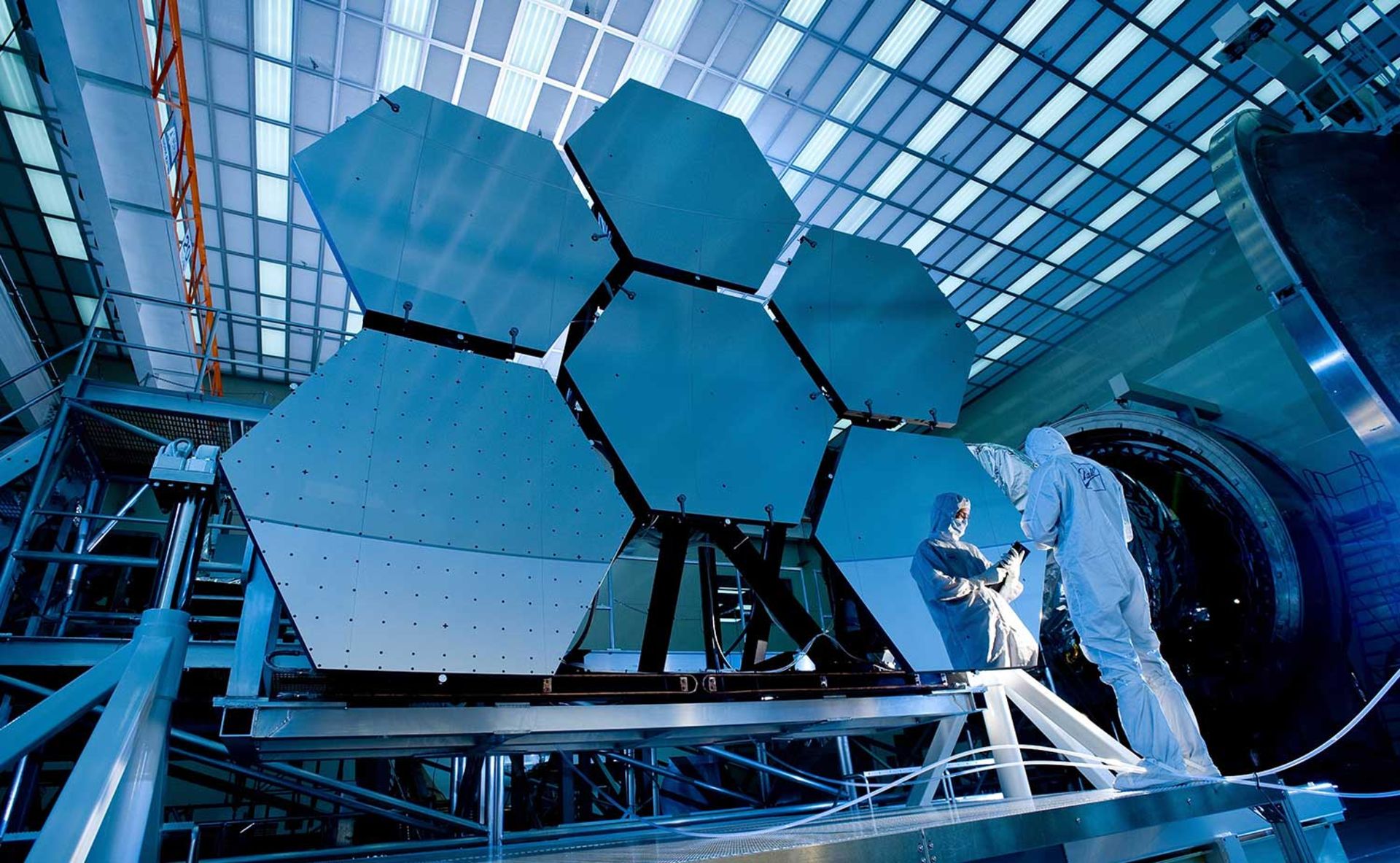
Hubble will be 31 years old in 2021. Engineers have designed Hubble so that it can be repaired and upgraded if necessary. Since Hubble’s launch, five space shuttle missions have taken astronauts near the telescope to repair and upgrade it. The last Hubble upgrade mission was in 2009. This telescope will no longer be repaired or upgraded, But it will continue to perform missions in space.
Meanwhile, NASA and its international partners are preparing the $9 billion James Webb Space Telescope. Named in honor of the NASA administrator (1968-1961) who played an important role in the Apollo space program, James Webb, this telescope is an infrared type that is larger than Hubble and capable of seeing inside clouds and particles in space. This telescope will not need repairs during its 6 to 10-year life. Instead of orbiting the Earth, the Webb Telescope will orbit the Sun at a distance of one million miles from the Earth, and therefore will be able to look much deeper into space, and the light that traveled only a few hundred million years after the Big Bang. had started to observe.
Although the launch of the James Webb Telescope has been regularly delayed, it is currently scheduled to launch in November 2021 (Aban 1400). Astronomers hope to have both telescopes in space at the same time before Hubble retires.
Read more: Involvement of the James Webb Space Telescope in a mission beyond its capacity
Interesting facts about the Hubble telescope
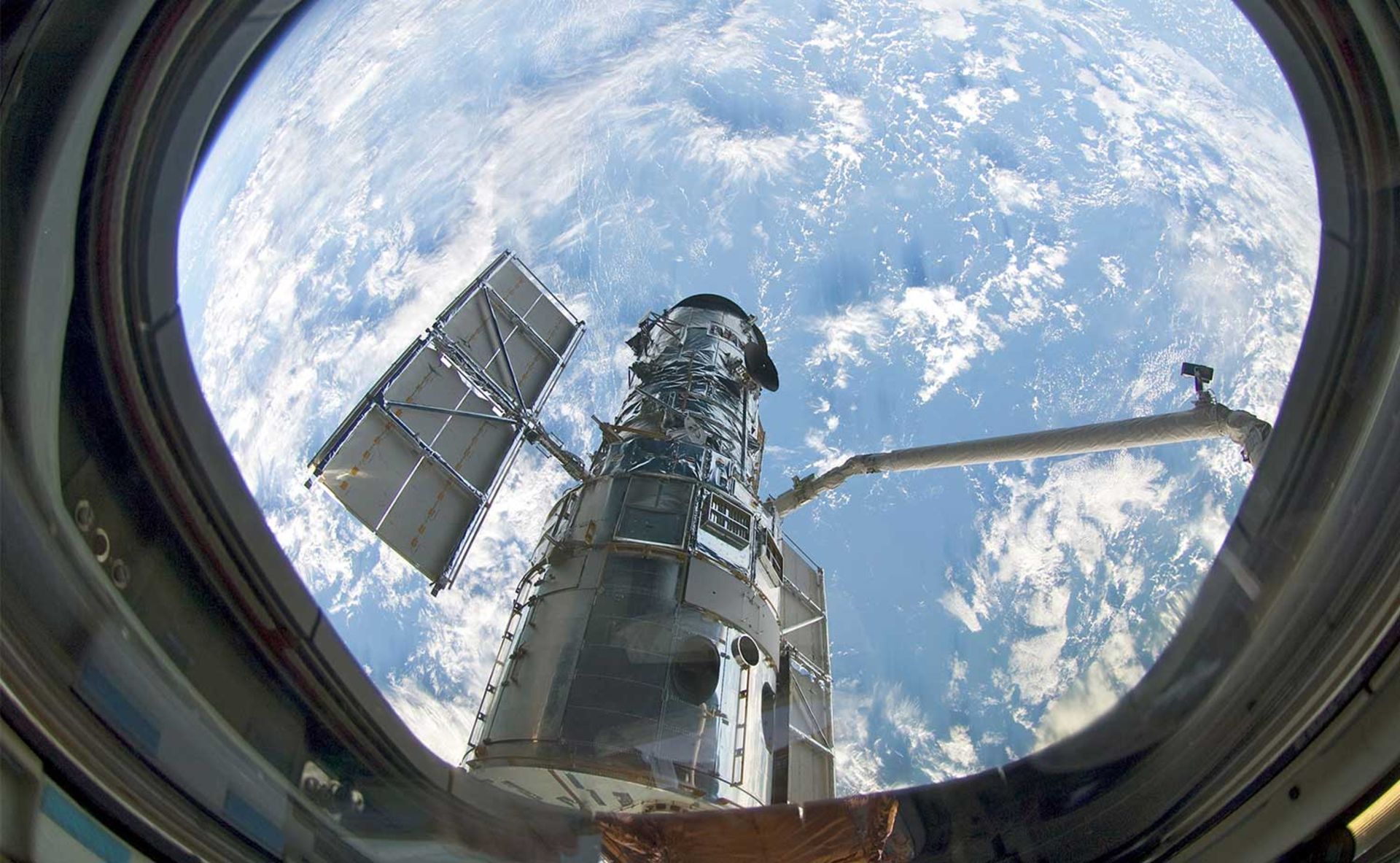
Mission
Launch: April 24, 1990, from space shuttle Discovery
Space deployment: April 25, 1990
First recorded image: May 20, 1990, of the star cluster NGC 3532
First repair and upgrade mission: December 1993
Second repair and upgrade mission: February 1997
Third repair and upgrade mission: December 1999 and February 2002
Fourth repair and upgrade mission: May 2009
size
Length: 13.2 meters
Weight (when launched): about 10,800 kg
Weight (after the fourth mission): about 12,200 kg
Diameter (at widest point): 4.2 meters
Space flight statistics
Near Earth Orbit: Altitude 547 km, 28.5 degrees inclined to the equator
Duration of a complete rotation around the earth: about 95 minutes
Speed: about 27 thousand kilometers per hour
Optical capabilities
Sensitivity to light: from ultraviolet to infrared (115-2500 nm)
Hubble mirrors
Primary mirror diameter: 2.4 meters
Primary mirror weight: 828 kg
Secondary mirror diameter: 0.3 m
Secondary mirror weight: 12.3 kg
Accuracy of targeting
To photograph distant objects with very low light, Hubble must be stable and extremely accurate. The telescope can lock onto a target up to a mile away without drifting more than seven-thousandths of an arc second (about the diameter of a human hair).
Statistical data
Hubble sends about 150 gigabytes of raw data to Earth every week, which is equivalent to about 45 two-hour HD movies or about 30,000 mp3 songs.
Energy consumption
Energy source: Sun
Mechanism: two solar panels of 7.62 meters
Power generation (in sunlight): about 5500 watts
Energy storage
Battery: 6 nickel-hydrogen batteries
Storage capacity: equal to approximately 22 car batteries
Anyone can register a request to use the Hubble telescope
The Johns Hopkins University Space Telescope Science Institute publishes a public call every year for applicants to use the Hubble telescope to register their applications. There is no limit to filing an application, But the competition among the applicants is extremely breathtaking.
Every year, hundreds of aspiring astronomers register their requests following the guidelines in this call, and after reviewing the panel of experts, only about one-fifth of them manage to get time to use the Hubble telescope. Those whose requests are denied can use a large archive of photos that become publicly available after a one-year period


You may like
-

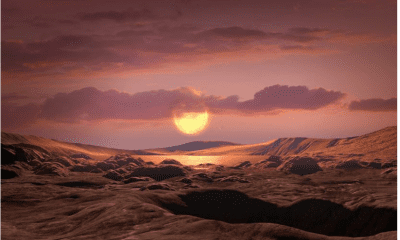


Most alien planets probably do not have day or night
-




The biography of Edwin Hubble
-

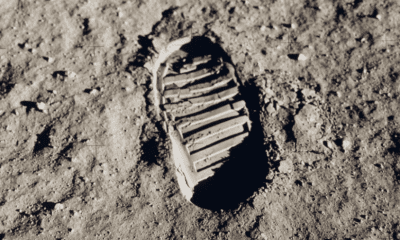


Can telescopes see astronaut footprints on the moon?
-




Can you really see the Great Wall of China from space?
-

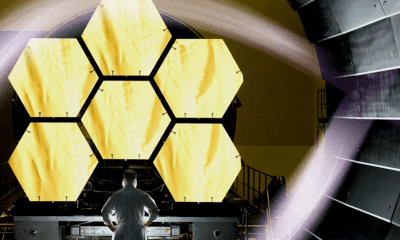


The James Webb Space Telescope; A look at the vastness of the universe
-

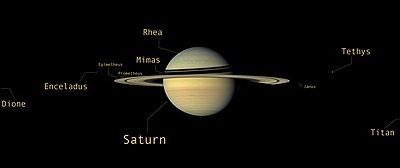


Moons of Saturn; Features and Explorations


Most alien planets probably do not have day or night
Do aliens sleep? You may take sleep for granted, but research suggests that many possible life-hosting planets may not have a day-night cycle. It is difficult to imagine the absence of day and night, but right now on Earth there are creatures living in lightless habitats in the depths or on the seabed, and they offer a vision of alien life without the existence of a circadian rhythm.
There are billions of potentially habitable planets in our galaxy; But how do we get to this number? The Milky Way has between 100 billion and 400 billion stars, seventy percent of which are cold and small red dwarf stars or M dwarfs.
According to a detailed survey of exoplanets in 2013, approximately 41% of red dwarf stars have a planet in their life belt. At this distance, the planet has the right temperature to support liquid water; Therefore, these planets have the potential to host liquid water.
We still do not know which of the discovered exoplanets have liquid water. However, 28.7 billion planets are only in the red dwarf life belt. We have not even considered the statistics of other types of stars like our sun.
 Planets close to red dwarfs are fatally locked to their star
Planets close to red dwarfs are fatally locked to their star
Rocky planets in the habitable belt of an M dwarf are called M Earths. M-Earths are fundamentally different from our Earth. One difference is that M dwarf stars are much cooler than our Sun. Also, M Earths are located at a close distance from their star, and for this reason, the gravitational influence of the star on them is strong.
The star’s gravity exerts a stronger force on the near side of the planet than on the far side. By creating friction, the planet’s rotation slows down until its orbital and translational rotations become synchronized over millions of years. Thus, M fields are likely to be deadlocked; So that one hemisphere of them is always facing the star and the other hemisphere is always behind it.
The year of a mortally locked planet is as long as its day. Earth’s moon also has a deadly lock on us. For this reason, we always see one side of it and cannot observe its hidden side.
A planet in mortal lock looks strange, But most possible habitable planets are of this type. Our nearest planetary neighbor, Proxima Centauri b, located in the Alpha Centauri system four light-years from Earth, is likely a fatally locked M-Earth.
As a result, unlike our Earth, M Earths have no day or night and even seasons; But terrestrial life, from bacteria to humans, has circadian rhythms corresponding to the day and night cycle. Sleep is one of the most obvious consequences of circadian rhythm.
On Earth, some creatures live in absolute darkness
The circadian cycle affects biochemistry, body temperature, cell regeneration, behavior, and much more. For example, people who are vaccinated in the morning produce more antibodies than people who are vaccinated in the afternoon; Because the response of the immune system is different during the day.
We cannot yet say with certainty how much periods of inactivity and regeneration affect life. Perhaps organisms that evolved without cyclical time never needed to rest.
If you doubt it, you can look at terrestrial organisms such as cave dwellers, deep sea life, and microscopic organisms in dark environments such as the earth’s crust and the human body that thrive in space away from daylight.
Many life forms have biological rhythms that are synchronized to stimuli other than light. Naked burrowing mice spend their entire lives underground and never see the sun, But their day and night hours are proportional to the daily and seasonal cycles of temperature and rainfall. Also, deep-sea bivalves and thermal well shrimps coordinate with ocean tides.
Bacteria that live in the human gut synchronize with melatonin fluctuations in the host’s body. Melatonin is a hormone in the body that is produced in response to darkness. Temperature changes that occur in thermal wells, humidity fluctuations chemical changes, and environmental currents can all cause biological fluctuations in the body of living organisms.
According to new research, M-Earths can have alternate cycles for days and seasons. To evaluate days and seasons on exoplanets, scientists have adapted climate models to simulate the environment of M-Earths and planets such as Proxima Centauri b.
According to the simulations, the contrast between the night and day sides of the planets produces gusts and atmospheric currents similar to Earth’s gust currents. If a planet has water, its dayside is likely to have thick thunderclouds.
The interaction between winds, atmospheric waves, and clouds can change the climate and produce regular cycles of temperature, humidity, and rainfall. The length of these cycles varies from hundreds to thousands of Earth days depending on the state of the planet, But it has nothing to do with the rotation period of the planet. Although the stars in the sky of these planets remain constant, the environment changes.
Perhaps life on M-Earths evolved to match biological rhythms and climatic cycles, or perhaps evolution arrived at a more exotic solution. One can imagine species that live on the day side of the planet going to the night side to rest and regenerate themselves.
These descriptions remind us that if life is out there, it can challenge assumptions we don’t know exist. The only certainty is that it will surprise us.


nameNoun: Any nounal word or phrase which indicates a particular person, place, class, or thing.
Noun: reputation.
Noun: An abusive or insulting epithet.
Noun: A person (or legal person).
Noun: Those of a certain name; a race; a family.
Noun: authority; behalf.
Noun: A unique identifier, generally a string of characters.
Noun: An investor in Lloyd’s of London bearing unlimited liability.
Verb: To give a name to.
Verb: To mention, specify.
Verb: To identify as relevant or important
Verb: To publicly implicate by name.
Verb: To disclose the name of.
Verb: To designate for a role.
Verb: To initiate a process to temporarily remove a member of parliament who is breaking the rules of conduct.
Noun: Any of several types of true yam () used in Caribbean Spanish cooking.
SProper noun: in which several of the axioms of ZF are derivable as theorems.
Noun: Any nounal word or phrase which indicates a particular person, place, class, or thing.
Noun: reputation.
Noun: An abusive or insulting epithet.
Noun: A person (or legal person).
Noun: Those of a certain name; a race; a family.
Noun: authority; behalf.
Noun: A unique identifier, generally a string of characters.
Noun: An investor in Lloyd’s of London bearing unlimited liability.
Verb: To give a name to.
Verb: To mention, specify.
Verb: To identify as relevant or important
Verb: To publicly implicate by name.
Verb: To disclose the name of.
Verb: To designate for a role.
Verb: To initiate a process to temporarily remove a member of parliament who is breaking the rules of conduct.
Noun: Any of several types of true yam () used in Caribbean Spanish cooking.
The biography of Edwin Hubble, the legendary astronomer who discovered the extragalactic space
Edwin Powell Hubble known as Edwin Hubble was a famous American astronomer who played an important role in formulating the basic principles of extragalactic and observational astronomy. Historians and astronomy experts consider him one of the most important astronomers in history. Hubble placed the space clouds, which before her time were known as gas and dust particles and were in the category of nebula or nebula, in the category of galaxies.. Historians consider Hubble’s discovery of other galaxies equal to Copernicus’ theory in terms of scientific value. Copernicus proved that the Earth is not at the center of the solar system, and Hubble proved that the Milky Way is not the center of the universe.
One of the important scientific relics of this astronomer is Hubble’s law in space. In short, this law states that the universe is expanding at a constant rate. In addition, in this law, the distance of each galaxy from the edge of the universe is directly proportional to its speed. Of course, this law was discovered two years before Hubble’s presentation by Georges Lemaitre, but its fame came to Hubble. The Hubble telescope is one of the most famous monuments built in the name of this legendary astronomer. An example of this telescope is installed in his hometown of Marshfield, Missouri. This telescope was sent into Earth orbit in 1990 to capture more detailed images of space outside the Milky Way.
Edwin Hubble has another great achievement in the field of cosmology and that is the classification of galaxies. This classification has been used by astronomers for many years. Hubble played a significant role in adding the astronomy category to the Nobel Prize. Of course, the sudden death of this scientist in 1953 prevented him from receiving this award.
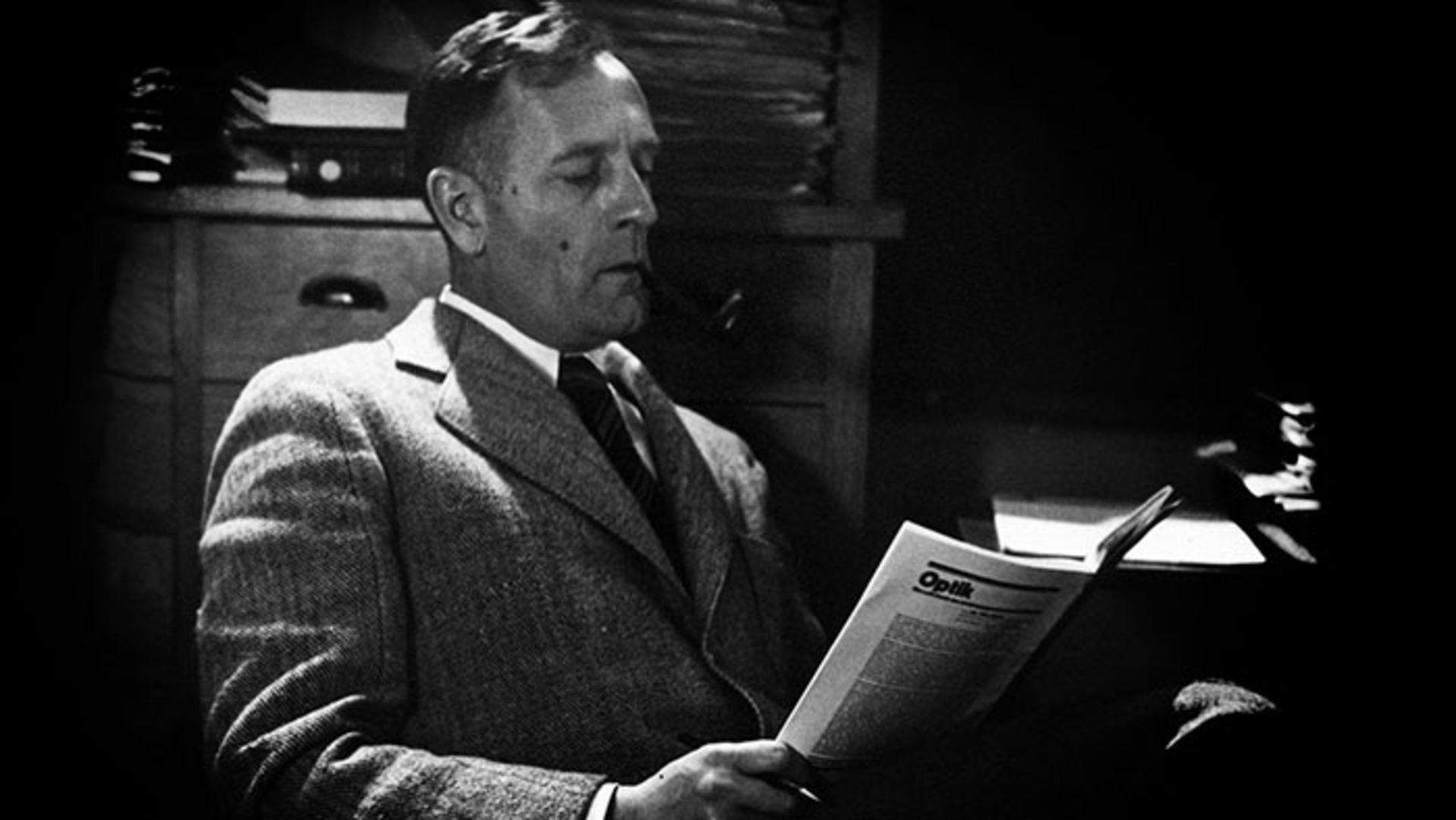
Birth and education
Edwin Hubbell was born on November 20, 1889, in Marshfield, Missouri. His mother was Virginia Lee James and his father was John Powell Hubble. His father was a lawyer and insurance businessman. Edwin was the third child out of 8 children in this family. Of course, like many children of those years, some of Edwin’s siblings died in childhood.
Hubbell lived in a rich family that had to migrate many times because of his father’s work style. During these trips, which were generally in cities around Chicago and Illinois, they lived in luxurious houses with many servants. The children of the Hubble family were all brought up with work and responsibility; Because their parents believed that this style of upbringing would increase their sense of responsibility.
Edwin Hubble was very interested in sports as a child and teenager
As a child, Edwin struggled to keep up with his older siblings and students, so he learned to read before school. He was very fond of adventure books by Jules Verne and H. Rider Haggard. Edwin’s grandfather was an amateur but enthusiastic astronomer. At the age of 7, he got acquainted with one of his grandfather’s telescopes and had his first experience of space exploration. The interesting thing is that instead of participating in the celebration, he observed the space with this telescope on his 8th birthday.
Hubble completed his high school education at Wheaton High School near Chicago. He finished high school easily and with excellent grades in English, mathematics, biology, chemistry, physics, Latin, and German languages. Of course, in high school, Edwin was more into sports than studying, and he owed his high grades to his innate intelligence. On his father’s advice, he was busy delivering goods on holidays. Finally, Edwin Hubbell graduated from high school in 1906 at the age of 16 and received a scholarship to the University of Chicago. He worked at this university as a laboratory assistant of the famous physicist Robert Millikan (Nobel Prize winner).
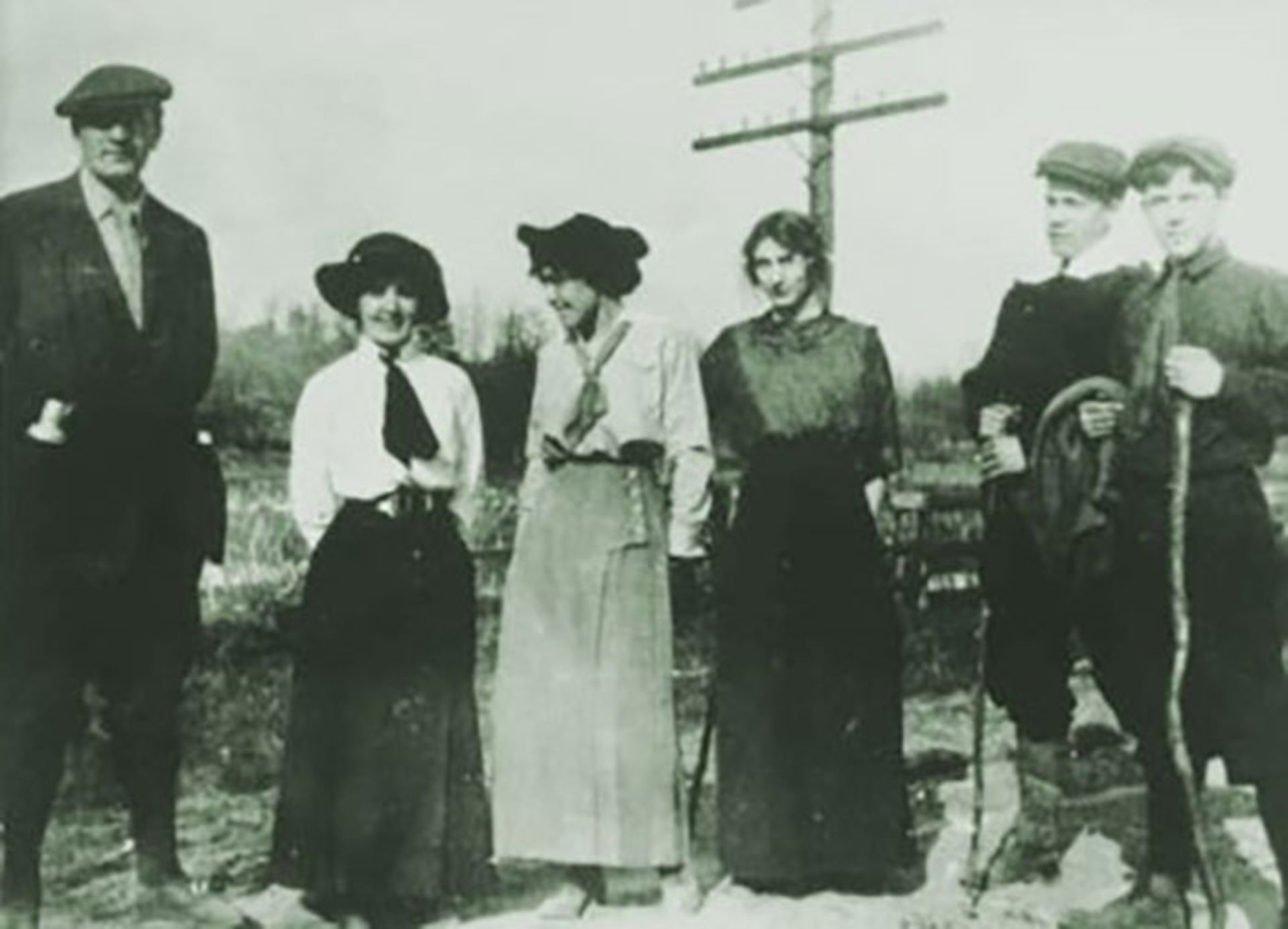
Edwin Hubble (left), with friends after returning from Oxford
After entering the university, sports still occupied a large part of Hubble’s time. He was fond of sports such as basketball and boxing. He was a tall and strong person and he left several records during his university days. Edwin Hubble graduated from the university in 1910 with a bachelor’s degree in general science and honors in physics and astronomy.
After graduating from the University of Chicago, Hubbell entered Oxford University with a Rhodes scholarship and studied there for three years. Hubble was quickly influenced by English culture and changed many of his past behaviors and habits and adopted an English appearance. Contrary to his strong interest in experimental sciences and especially astronomy, he chose the field of law theory out of respect for his father and graduated from Oxford in 1912. He stayed at this university for another year and studied Spanish. While studying at Oxford, Hubble had another achievement including traveling around Europe. In these trips, in addition to having fun, he paid special attention to planning and thinking about his future. In those years, Edwin wrote in a letter to his mother:
Work is pleasant when it is for a great purpose and end. A goal so great that the thought of it and the anticipation of its achievements, will remove all the fatigue of the difficult task. When I find the purpose and principles I want, I leave everything for it and dedicate my life to it.
Edwin’s father died in the fall of 1912. He asked his father for permission to leave Oxford to visit him but was refused. Young Edwin remained in Oxford and his father died in January 1913.
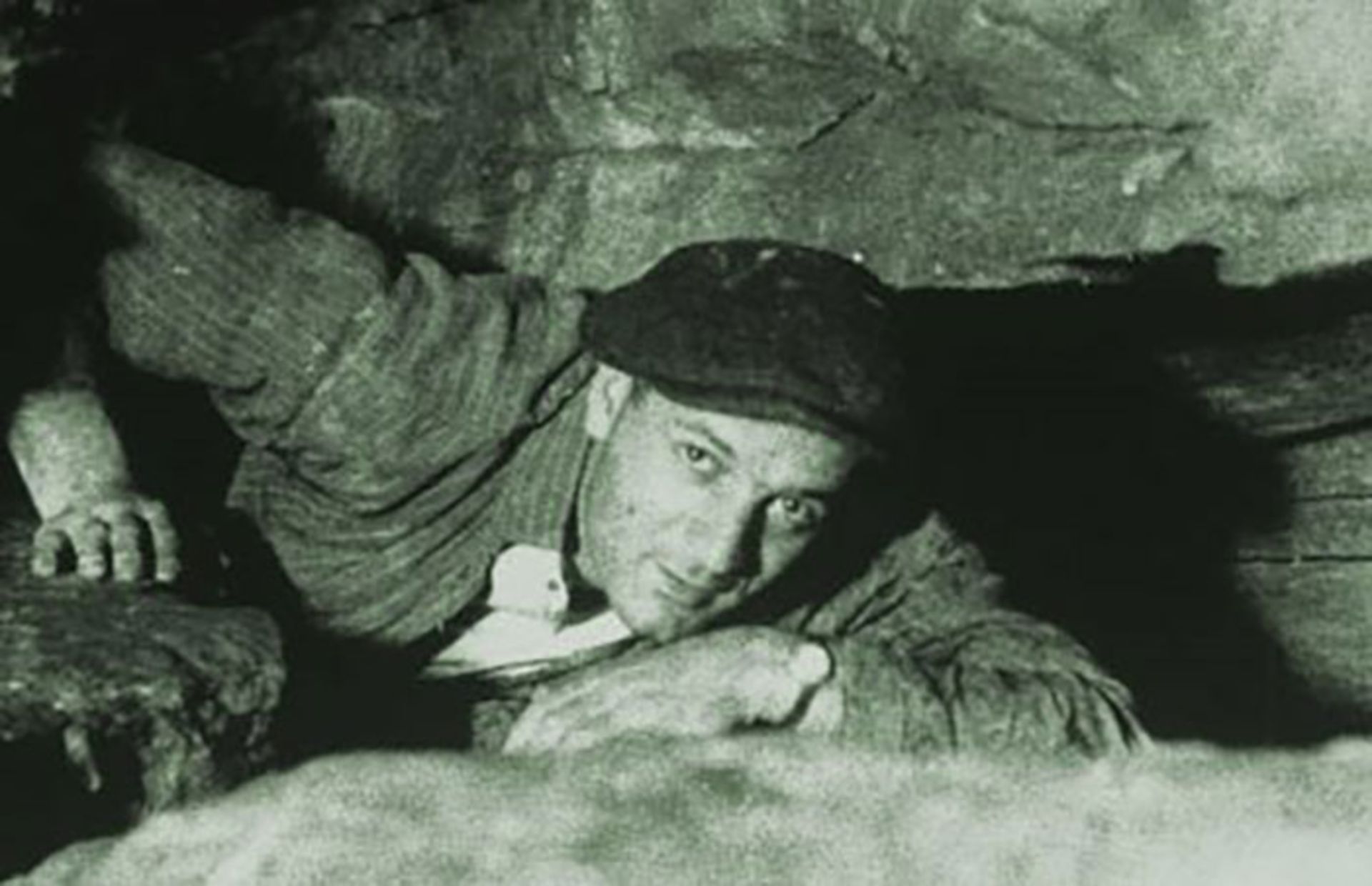
Hubble exploring the cave
His Career
Hubble’s first job was teaching high school Spanish and physics.
Edwin Hubble returned to America in the summer of 1913. He was employed as a Spanish and Physics teacher at New Albany High School in Indiana. In addition, he coached the school’s basketball team and had a part-time job as a German translator. Although Hubble was a popular teacher, he did not enjoy his job. For this reason, he corresponded with Forrest Ray Moulton, professor of astronomy at the University of Chicago, and asked him for advice on collaborating on astronomy projects and higher education in this field. Moulton also introduced Hubble to Edwin Frost, director of the Yerkes Observatory in Wisconsin. In his letter, he introduced Hubble as a hardworking person, enthusiastic about science, and useful to Frost.
Finally, at the age of 24, Edwin entered the field of science, which he had become interested in nearly two decades ago by observing space through the lens of his grandfather’s telescope. Upon entering the observatory, he began his doctoral course in astronomy and received his degree in 1917 with a thesis entitled Photographic Investigations of Faint Nebulae. With the outbreak of World War I, Hubble served in the army for a year and rose to the rank of colonel despite not being actively involved in combat. He then went to Cambridge University to study astronomy.
Edwin Hubble started working at the Mount Wilson Observatory in California in 1919 at the age of 30. This observatory is famous for its excellent weather and excellent observation conditions. These factors made Hubble research in this place until the end of his life.
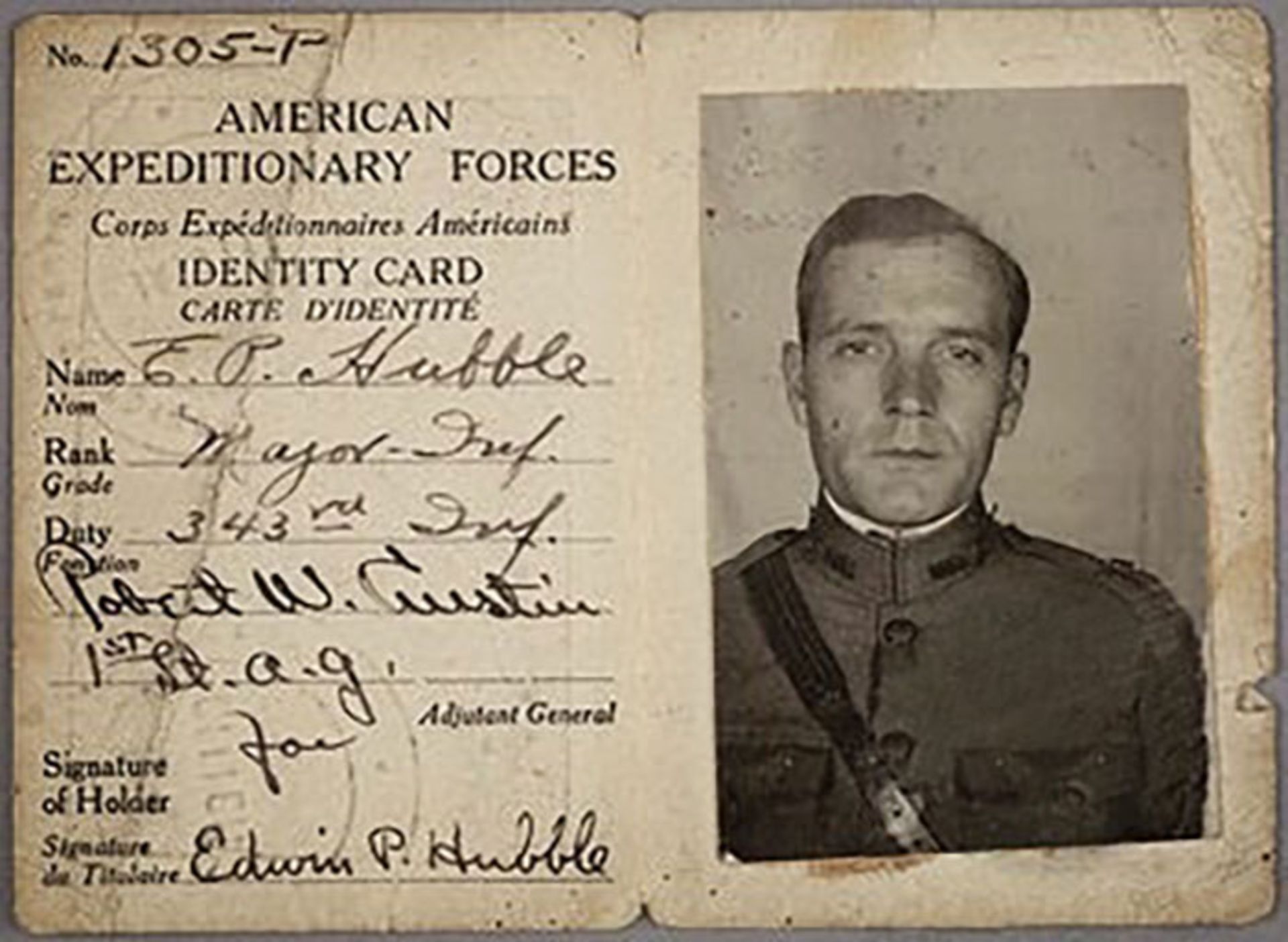
Hubble membership card in the army
Scientific achievements
As mentioned, Hubble wrote his doctoral dissertation on nebulae. He continued his research at Mount Wilson using the world’s largest telescope, the Hooker telescope. Hubble’s great discoveries, including galaxies beyond the Milky Way and the phenomenon of redshift, were the results of this astronomer’s research using the Hooker telescope.
In 1912, the American astronomer Henrietta Leavitt published an important discovery related to stars called the Cepheid variable. Beginning in the 1930s, Hubble was able to discover similar stars in nebulae using the Hooker telescope. While studying the Andromeda Nebula, he realized that these stars are very far from Earth and much farther than the stars of the Milky Way.
The discovery of other galaxies and the greatness of the universe was the greatest achievement of this scientist
Eventually, Hubble discovered that the Andromeda Nebula is actually a galaxy. Until then, most astronomers believed that the Milky Way and the Universe were a single entity. Hubble discovered that the universe is much larger than the Milky Way and consists of “island universes”. His findings in this historical discovery are summarized as follows:
- His high-quality images of Andromeda and the Triangulum Nebula showed a massive cluster of stars.
- Many of the stars were of the Cephasian type.
- The studied nebula is one million light years away from Earth. 4 times more than all the objects that had been discovered until that time. (Of course, this distance is proven to be equal to 2.5 million light-years today.)
- The diameter of the Andromeda Nebula is 30 thousand light years. (Today, these dimensions have been proven to be 220,000 light years.)
- Andromeda galaxy emits light equal to one billion suns of our system.
Hubble published his findings three days after his 35th birthday. Of course, his discoveries were not published in a scientific journal, but in the New York Times. The results of his research were debated among astronomers for some time, and finally, his paper was reviewed at the meeting of the American Astronomical Society on January 1, 1925. Hubble changed everyone’s view of the universe with his discoveries. He proved that our vast galaxy, host to the Sun and hundreds of billions of similar stars, is only one of the billions of galaxies in the universe.

Andromeda Galaxy
In addition to this discovery, Hubble provided a standard for classifying galaxies that was used by astronomers for years.
Redshift phenomenon
Prominent astronomer Veslu Slifer has also researched nebulae. He stated in his report in 1913 that the light of the nebula tends towards the red color of the color spectrum. He explained his discovery as a form of the Doppler effect. According to the same explanation, the light tends to the red side of the color spectrum as the emission source moves away, similar to the Doppler effect. To test his discovery, Slifer studied many nebulae. He came to the conclusion that the light of many of these nebulae has a fast transition towards red color and as a result, they are moving away from Earth at a high speed.
Hubble stated that galaxies are moving away from each other at high speed
In 1929, using Slifer’s findings and combining them with his own discoveries and his assistant Milton Humson’s, Hubble was able to find an explicable relationship between galaxy distance and redshift state. He recorded his findings in a formula known today as Hubble’s law. This formula is displayed as v = Hr, where v is the velocity, r is the distance, and H is Hubble’s constant. This constant was first named as 530 by Hubble, but today, using advanced research and tools, the exact number is 70.
The world is expanding
One of the main interpretations of Hubble’s law is that we live in an expanding universe. Of course, Hubble himself believed that there is not enough credible evidence to prove this interpretation of the redshift effect. The remarkable point is that although Hubble drew the attention of the scientific community to this law, the law was discovered two years earlier by Georges Lemaitre. In fact, Lemaitre’s interpretation of this law is more accepted by new cosmologists; Because he used Einstein’s law of relativity for his interpretation.
However, Hubble’s point of view was quite logical. He believed that the theory of red shift can only be accepted as a proof of the expansion of the universe when the density of matter in the universe is much higher than the amount discovered up to that time. These statements have been the basic foundations for the proof of dark matter in the universe. Hubble said about the density of materials needed to prove the effect of redshift:
The required density of matter is several times higher than the estimated maximum density of matter concentrated in the nebula. Furthermore, we have no evidence of significant interstellar matter increasing the density.

Classification of galaxies by Hubble
However, although Hubble had a lot of resistance to accept the effect of redshift, in his research he found that the speed of this expansion is slowing down. However, these findings and research on the speed of galaxy expansion are still ongoing and astronomers discover new issues every day.
One of the historical events regarding the theory of the expanding universe is Albert Einstein’s meeting with Edward Hubble in 1931. The two met at Mount Wilson Observatory. In 1917, in his theory of relativity, Einstein considered the universe to be constant and without change in size. He did not see any end or end to the universe. Although his research showed signs of the expansion of the universe, this scientist tried to deny it by determining a constant called the cosmic constant.
However, the January 1931 meeting earned Hubble the nickname of the man who forced the world’s smartest man to change his mind. This meeting caused Einstein to call his previous calculations the biggest mistake of his scientific life, and as a result, Hubble’s findings became the center of attention in scientific circles.
The Big Bang theory is influenced by the findings of this scientist about the expansion of the universe
In 1935, Hubble discovered the 1373 asteroid named Cincinnati. A year later he published the book ” The Realm of the Nebulae “. This book is a historical interpretation of his experiences and research on intergalactic astronomy. With the outbreak of World War II, Hubble once again served in the US Army at the Aberdeen Proving Ground. He was in charge of the ballistics research department in this area. His extensive research resulted in several improvements in the power of ballistic bombs and projectiles. One of his major practical achievements in this research was the improvement of ballistic projectile components, which resulted in a high-speed camera to study the characteristics of the bomb after launch. After the war, Hubble returned to Mount Wilson and spent some time at the Palomar Observatory in California.

Edwin Hubble in old age
In addition to scientific research, Edwin Hubble worked hard to convince the Nobel Prize Society to add astronomy to the award’s branches. He intended to add this science to this event as an independent subsection of physics. He believed that the efforts of astronomers in stellar physics should be appreciated. Unfortunately, after Hubble’s death, this society decided to appreciate this science as a branch of physics.
Personal life and death
Edwin Hubbell married Grace Burke Leib in 1924 at the age of 34 . They had no children. One of Hubble’s pastimes was collecting books. He was generally interested in books related to the history of science. In addition to scientific research, Hubble was also a member of the Board of Trustees of the Huntington Library in San Marino. The discovery of distant galaxies made him so famous that in 1948 his picture appeared on Time magazine. He and his wife had a close relationship with Hollywood stars and artists such as Aldous Huxley.
In 1949, at the age of 59, Edwin Hubbell suffered a heart attack while on vacation in Colorado and was nursed back to health by his wife. Of course, after this incident, the intensity of his research activities decreased until he died on September 28, 1953, due to a blood clot in the brain. He had willed that his burial place should not be known and personal notes were also destroyed by his wife. Grace also died in 1980 and was buried in a secret place next to her husband.
Awards and honors
The Cleveland Newcomb Prize was awarded to Edwin Hubble in 1924. In 1938, he was awarded the Bruce Medal, and a year later, he was awarded the Franklin Medal Science and Engineering Award by the Franklin Institute in Philadelphia. The Gold Medal of the British Royal Astronomical Society was awarded to this legendary astronomer in 1940. The Legion of Honor, which is a military award from the US Armed Forces, was awarded to him in 1946 for his research in the field of ballistics.

Hubble Space Telescope
After the death of Edwin Hubble, in addition to the aforementioned awards, other honors were also registered to pay tribute to this American scientist. The Missouri City Hall of Fame inducted Edwin Hubbell in 2003. In 2008, a commemorative stamp was printed in the name of this scientist, and in 2017, the Indiana Basketball Hall of Fame registered Hubble’s name.
Asteroid number 2069 and a hole in the moon are among the celestial objects that are registered in the name of this scientist. A planetarium at Edward R. Morrow High School in Brooklyn was also named after this scientist, and a street in Missouri was named after Edwin Hubble.
Certainly, the most famous monument of Edwin Hubble is the Hubble Space Telescope, which was launched in 1990. The main purpose of launching this telescope was to accurately calculate Hubble’s constant in his famous formula. Anyway, astronomers with this telescope first considered the number 72 as a constant in 2001, and then in 2006, by studying the microwave background of the galaxy, they reached the exact number 70. In addition, the Hubble telescope made it possible to observe not only the expansion of the universe but also the acceleration of this expansion. Today, the force that caused this expansion is called dark energy in scientific documents.


Can telescopes see astronaut footprints on the moon?
In the early 2000s, when there were occasional people who believed that the moon landing was a hoax, the argument was made that if NASA’s Hubble Space Telescope was powerful enough to see the tiny details of distant galaxies, why couldn’t it take the shoes of the Apollo astronauts on the moon?
The aforementioned argument, like many conspiracy theories, seems convincing on the surface; But with the slightest scrutiny, it loses its value. Those who are fooled by this claim are wrong about two things: how telescopes work and how big space is.
Astronomer Phil Platt explains on the Scientific American website that many people think a telescope’s job is to magnify images. Of course, manufacturers of cheap telescopes like to advertise them this way, printing statements like “150x magnification power” in big letters on the box of the telescopes, along with very misleading pictures of much larger telescopes. Although magnification is important, the true power of a telescope is in its resolution. This difference is subtle but very important.
Magnification is how much you can focus on an object and make it appear larger. This is important because while astronomical objects are physically very large, they are very far away and thus appear small in the sky. Magnifying them makes them easier to see.
Magnification is important, but the true power of a telescope is in its resolution
On the other hand, clarity or resolving power is the ability to differentiate between two objects that are very close together. For example, you might think of two stars orbiting each other (a binary star) as one star; Because their distance is very small and the naked eye cannot distinguish them. But if you look at them with a higher-resolution telescope, you may be able to see that they are two separate stars.
Isn’t that the Zoom? No; Because zooming in only makes everything bigger. This can be easily illustrated with the following image: zoom in as much as you want on the image, but once you pass a certain limit, you only enlarge the pixels and get no new information. To overcome this obstacle, you need to have high resolution rather than zoom.
 Hubble Space Telescope image of the Apollo 17 landing area in the Taurus-Lytro Valley of the Moon. This image lacks the necessary resolution to show the traces of the moon landing or the movement of astronauts on the moon.
Hubble Space Telescope image of the Apollo 17 landing area in the Taurus-Lytro Valley of the Moon. This image lacks the necessary resolution to show the traces of the moon landing or the movement of astronauts on the moon.
The problem is that resolution depends on the telescope itself, meaning that a dramatic increase in resolution usually requires a much larger telescope; But no matter how big your telescope gets, it will still have limited resolution.
When light from an infinitesimal point, such as distant stars, passes through a telescope, the light is slightly scattered within the telescope’s optical instruments (mirrors or lenses). This fundamental property is called light diffraction and is unavoidable. The resolution of telescope images depends partly on the size of its mirror or lens. The larger the telescope’s light-gathering instrument, the higher its image resolution.
The way light propagates in optical equipment depends on wavelength, with shorter wavelengths producing higher resolution. So two nearby blue stars may be distinguishable in a telescope, while two red stars at the same distance may not be distinguishable.
When deciding on the size of a telescope’s camera pixels, astronomers must consider the wavelength they want to observe. Otherwise, they just magnify the noise; Like the previous example about zooming too much on the photo.
All these lead to an amazing result. The Hubble Space Telescope has a mirror with a diameter of 2.4 meters and the James Webb Space Telescope (JWST) has a mirror with a diameter of 6.5 meters. Therefore, the resolution of the James Webb telescope images can be expected to be much higher. At some wavelengths, it is: the shortest wavelength that the James Webb Space Telescope can see is about 0.6 microns (what our eyes perceive as orange light), and the resolution is technically much better than that of the Hubble image.
However, the James Webb Space Telescope was designed as an infrared telescope. At those wavelengths, say around two microns, the resolution is comparable to what Hubble can see at visible light wavelengths. In the mid-infrared, i.e. wavelengths of 10 to 20 microns, the resolution of the James Webb Space Telescope images is even lower. However, because the James Webb is the largest infrared telescope ever sent into space, it can provide the sharpest images we’ve ever had at these wavelengths.
 No telescope on Earth or in low Earth orbit can capture an image like this, a high-resolution view of a boot on the moon’s surface.
No telescope on Earth or in low Earth orbit can capture an image like this, a high-resolution view of a boot on the moon’s surface.
Astronomers measure resolving power as an angle on the sky. From the horizon to the highest point of the sky is 90 degrees and each degree is divided into 60 arc minutes and each arc minute into 60 arc seconds. For example, the angular diameter of the moon from our point of view in the sky is about half a degree. That is, if we look at the moon from the Earth, the moon in the sky occupies a space equal to half a degree of the full circle of the sky, which is equivalent to 30 minutes of arc or 1800 seconds of arc.
The maximum resolution of a telescope refers to the smallest angular distance between two objects that the telescope is able to distinguish as two separate objects. This resolution is expressed as an angle.
At its best, the resolution of the Hubble telescope is about 0.05 of an arc, which is considered a very small angle. But the amount of detail Hubble is able to see depends on the distance and physical size of the target. For example, 0.05 seconds of arc is equivalent to the apparent size of a small coin that can be seen from about 140 km.
In this way, we return to the discussion of conspiracy theorists and their claims regarding the observation of astronaut footprints on the moon. Galaxies are usually tens of millions or even billions of light years away from Earth. At those distances, the Hubble telescope can distinguish objects with dimensions of several light years (i.e. tens of trillions of kilometers) with its best resolution. So even though it looks like we’re seeing galaxies in great detail in those amazing Hubble images, the smallest we can see is still pretty big.
At the same time, the moon is only about 380 thousand kilometers away from us and from the Hubble telescope. At this distance, the resolution of the Hubble telescope is surprisingly limited, unable to resolve objects smaller than about 90 meters. As a result, not only can we not see the astronauts’ footprints in the Hubble images, but we can’t even see the Apollo moon landings, which are about four meters across. Hubble’s resolution at this distance is so limited that it cannot distinguish details smaller than about 90 meters, so it is not possible to see objects smaller than this on the Moon.
 An image of the Apollo 11 landing site captured by NASA’s Lunar Reconnaissance Orbiter (LRO). Although the LRO telescope uses much smaller lenses than the Hubble Space Telescope, its proximity to the lunar surface has made it possible to see details such as the Apollo 11 lunar lander and astronauts’ footprints.
An image of the Apollo 11 landing site captured by NASA’s Lunar Reconnaissance Orbiter (LRO). Although the LRO telescope uses much smaller lenses than the Hubble Space Telescope, its proximity to the lunar surface has made it possible to see details such as the Apollo 11 lunar lander and astronauts’ footprints.
In the images taken by the Nass Lunar Reconnaissance Orbiter (LRO), we can see the moon landings and the footprints of the astronauts. Although the camera of this orbiter has a mirror with a diameter of only about 20 cm, the spacecraft is in lunar orbit and passes the Apollo landing sites at an altitude of 50 km.
The reason NASA’s Lunar Reconnaissance Orbiter can see more detail on the surface of the moon is because it is so close to the surface of the moon. This is why we send probes to planets: it allows us to get much better pictures of them. Sometimes, there’s no substitute for being there.
The lesson we learn from this topic is that the way tools actually work is often more complex and different than we expect. Furthermore, claims that may seem reasonable fall apart with a little scientific scrutiny. If a telescope is only advertised based on magnification, it’s best not to buy it and look for other options. It may seem difficult, but with a little determination, you will succeed.


Do animals have an understanding of the concept of death?


What is Kali Linux? Everything you need to know about this popular but mysterious distribution


Sony Brand Story; From the production of rice cookers to becoming one of the most famous companies in the world


How did the people of the past imagine the future?


Mammoth and dodo return to nature


Canopus; What do we know about the second brightest star in the sky?


How to use iMessage on Android?


Can humans endure the psychological torment of living on Mars?


Xiaomi Glorimi M2 Max watch review; Alternative economic option for iPhone owners


Artificial intelligence problems; Frauds based on artificial intelligence and methods to deal with them
Popular
-



 Technology1 year ago
Technology1 year agoWho has checked our Whatsapp profile viewed my Whatsapp August 2023
-



 Technology1 year ago
Technology1 year agoSecond WhatsApp , how to install and download dual WhatsApp August 2023
-



 Technology1 year ago
Technology1 year agoHow to use ChatGPT on Android and iOS
-



 AI2 years ago
AI2 years agoUber replaces human drivers with robots
-



 Technology1 year ago
Technology1 year agoThe best Android tablets 2023, buying guide
-



 Technology1 year ago
Technology1 year agoThe best photography cameras 2023, buying guide and price
-



 Humans2 years ago
Humans2 years agoCell Rover analyzes the inside of cells without destroying them
-



 Technology1 year ago
Technology1 year agoHow to prevent automatic download of applications on Samsung phones
